Article and photos by Joe Sapia (except as noted)
Note: The yard references are to my house in the section of Monroe between Helmetta and Jamesburg in South Middlesex County. My yard is in a Pine Barrens outlier on the Inner Coastal Plain, the soil is loamy, and my neighborhood is on the boundary of Gardening Zones 6b (cooler) and 7a (warmer). Notes and photographs are for the period covered, unless otherwise noted.
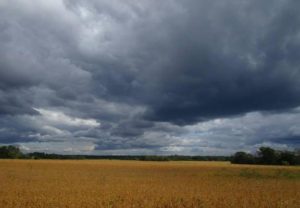
Gray clouds over Monroe farmland, looking toward the Jamesburg Park Conservation Area. Beautiful cloudy skies have presented themselves in recent years over my hometown of Monroe.
FALL HAS ARRIVED: Despite the summer-like temperatures the Jersey Midlands have been experiencing, fall is here. The calendar proclaims the beginning of fall at the September equinox – this year, September 22, when the day’s light and dark are generally equal. However, I regard fall beginning September 1 and running through October and November.
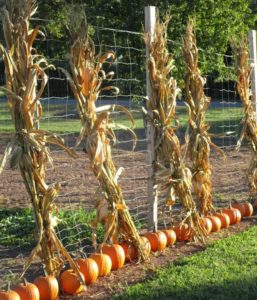
A fall scene at Griggstown Farm in Franklin, Somerset County.
DEER RUT: The mating season, or rut, for deer, “Odocoileus virginianus,” normally peaks from late October to mid-December. Here is Nixle.com-South Brunswick, Middlesex County, advisory:
“The South Brunswick Police Department is reminding motorists to be alert for increased deer activity over the next six weeks. This is typically when we see an increase in car crashes involving deer. The deer can unexpectedly dart onto roads so motorists need to use extra caution. “Motorists are urged to be especially attentive and cautious during morning and evening commutes when visibility may be poor. Deer are involved in thousands of collisions annually in New Jersey, with as many as half coming during the fall mating season, or rutting season…. An adult male deer can weigh 150 pounds or more.
“In the past month there have been a half dozen crashes involving deer in South Brunswick. In past years the majority of crashes have taken place over the next 6 weeks.
“…Deer are most active in the very early morning and around sunset, when visibility conditions can be very difficult. Using caution while driving will become even more important when Daylight Saving Time ends November 6, causing commutes to align with periods when deer are most active. For motorists, low levels of light and sun glare can make it very difficult to see deer that are about to cross the road. Moreover, multiple deer may cross the road at any given moment, usually in a single file.
The following tips can help motorists stay safe during from deer crashes:
-If you see a deer, slow down and pay attention to possible sudden movement. If the deer doesn’t move, don’t go around it. Wait for the deer to pass and the road is clear.
-Pay attention to ‘Deer Crossing’ signs. Slow down when traveling through areas known to have a high concentration of deer so you will have ample time to stop if necessary. If you are traveling after dark, use high beams when there is no oncoming traffic. High beams will be reflected by the eyes of deer on or near roads. If you see one deer, be on guard: others may be in the area. Deer typically move in family groups at this time of year and cross roads single-file. Don’t tailgate. Remember: the driver in front of you might have to stop suddenly to avoid hitting a deer.
-Always wear a seatbelt, as required by law. Drive at a safe and sensible speed, considering weather, available lighting, traffic, curves and other road conditions.
-If a collision appears inevitable, do not swerve to avoid impact. The deer may counter-maneuver suddenly. Brake appropriately, but stay in your lane. Collisions are more likely to become fatal when a driver swerves to avoid a deer and instead collides with oncoming traffic or a fixed structure along the road.
-Report any deer-vehicle collision to a local law enforcement agency immediately.
-Obey the state’s hands-free device law or, better yet, avoid any distractions by refraining from using cellular devices while driving.

I encountered these deer near Rutgers University–Douglass College in New Brunswick, Middlesex County. These are city deer, allowing me to get within 30 or so feet of them.
WEARING BLAZE ORANGE: With the popular deer-hunting season underway, it is probably a good time to wear blaze orange in the woods. Actually, a few years ago, I started wearing blaze orange on my knapsack year-round, because it is hard to keep track of hunting. During the last deer-hunting season, I walked under a tree-stand with a hunter, never seeing him until he spoke to me. Fortunately, I wore blaze orange. (The incident showed me, no matter a life spent in the woods, I let down my awareness.)

My blaze orange vest and one of my blaze orange hats.
BALDFACED HORNET NESTS: As we transition from the warm weather season to the cold, baldface hornets, “Dolichovespula maculate,” will abandon their nests. The abandoned nest is not a threat and may make a folksy bringing-of-the-outdoors-inside ornament. I have two hanging, with another waiting to be hung, in my cellar “cabin” area. Scope your nest now, but wait for colder weather to make sure it is fully abandoned. (Even in season, these nests are not a threat, if far-enough away from human activity. See this Pennsylvania State University Extension factsheet, http://ento.psu.edu/extension/factsheets/baldfaced-hornet.)
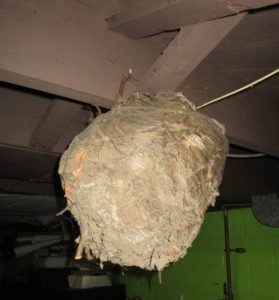
A baldfaced wasp nest on display in my cellar.
MONARCH BUTTERFLIES: Last week, I mentioned monarch butterflies, “Danaus plexippus,” would be heading on their southern migration to either Florida or, more likely, Mexico. The monarchs we see now are a “super generation,” the great-grandchildren of last fall’s migration and these making the complete trip south, if they survive. This week, I was able to photograph one in my garden as it visited the zinnias.
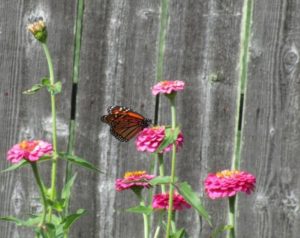
A monarch butterfly on the zinnias in my garden. If all goes right, this butterfly will migrate to at least Florida or, more likely, Mexico. Good luck!
ZINNIAS AND LETTUCE: This week, my zinnias went to Teddy’s luncheonette in Cranbury, Middlesex County, and the Hightstown Diner in Hightstown, Mercer County. The fall lettuce crop in my garden is growing nicely.
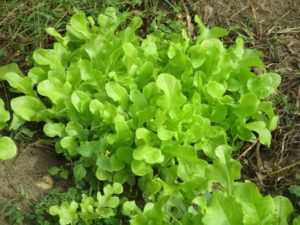
The fall lettuce crop in my garden.
GARDEN VOICES: Paul Migut, who gardens in South River, Middlesex County, checked in: “(I) pulled out all Rutgers and yellow tomatoes. (I) still have two grape/cherry tomatoes and two bush beans. And, of course, the ‘surprise’ turnips still growing. Enjoy the Fall season.”
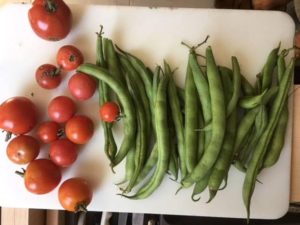
Cherry tomatoes and bush beans from Paul Migut’s garden in South River, Middlesex County. (Photograph copyright 2017 by Paul Migut.)
BEAUTIFUL CLOUDS: The beautiful cloud formations continue. This week, among the places I photographed them was “Jamesburg Lake” (properly “Lake Manalapan”) on the Jamesburg-Monroe boundary, Middlesex County.

Clouds over “Jamesburg Lake,” Middlesex County.
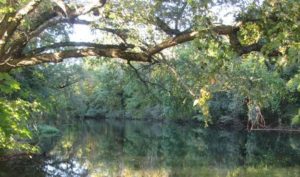
The Delaware and Raritan Canal on the boundary of Rocky Hill and Franklin, Somerset County.
OCEAN TEMPERATURES: Atlantic Ocean temperatures on the New Jersey coast were about 68 degrees to 70 degrees during the weekend of September 30-October 1.
SUNRISE/SUNSET: For October 1, Sunday, to October 7, Saturday, the sun will rise about 6:55 to 7 a.m. and set about 6:30 to 6:40 p.m. For October 8, Sunday, to October 14, Saturday, the sun will rise about 7:05 a.m. and set about 6:25 p.m.
THE NIGHT SKY: The next full moon is the Full Harvest Moon Thursday, October 5.
WEATHER: The National Weather Service forecasting station for the area is at http://www.weather.gov/phi/.
UPCOMING: Another “Rally for the Navesink” meeting is scheduled for Tuesday, October 3, 5:30 p.m., at the Monmouth Boat Club, 31 Union Street, Red Bank. The Rallies are an effort of environmental groups, the community, and municipal, Monmouth County, and state governments to promote improvement of the Navesink River in Monmouth County. The river suffers from high fecal bacteria counts and depleted oxygen levels. More information on the Rally is available from Clean Ocean Action, telephone 732-872-0111, website www.cleanoceanaction.org.

The Navesink River in September, looking downstream from Middletown toward Sea Bright, Monmouth County.

The recent photograph shows Sandy Hook, where the Atlantic Ocean and Raritan Bay meet, from an airplane flight leaving LaGuardia Airport in New York City. Humans, how small we are! (Photograph copyright 2017 by Dan Mulligan, a Long Branch, Monmouth County, kid who, now, lives in Cranbury, where he is on the Township Committee and has served as mayor.)
Joe Sapia, 60, is a lifelong Monroe resident. He is a Pine Barrens naturalist and an organic vegetable-fruit gardener. He gardens the same backyard plot as did his Italian-American father, Joe Sr., and his Polish-immigrant, maternal grandmother, Annie Poznanski Onda. Both are inspirations for his food gardening. Joe is active with the Rutgers University Master Gardeners/Middlesex County program. He draws inspiration on the Pine Barrens around Helmetta from his mother, Sophie Onda Sapia, who lived her whole life in these Pines, and his Grandma Annie. Joe’s work also is at @JosephSapia on Twitter.com, along with Facebook.com on the Jersey Midlands page.
Article and photos by Joe Sapia
Note: The yard references are to my house in the section of Monroe between Helmetta and Jamesburg in South Middlesex County. My yard is in a Pine Barrens outlier on the Inner Coastal Plain, the soil is loamy, and my neighborhood is on the boundary of Gardening Zones 6b (cooler) and 7a (warmer). Notes and photographs are for the period covered, unless otherwise noted.

Dawn on the Delaware River, looking downstream from Hamilton, Mercer County, to the other side of the river and Bucks County, Pennsylvania.
ABBOTT MARSHLANDS: The Abbott Marshlands are about 3,000 acres, about 1,300 wetlands and 1,700 uplands, along the Delaware River on the boundary of Burlington and Mercer counties in the Bordentown-Trenton area. An interesting point of the marsh is that it is both freshwater and tidal. While Delaware River saltwater going inland ends between the Delaware Memorial Bridge and Philadelphia, the tidal effect continues for miles upstream to the Marshlands. The Marshlands also are known as the Trenton Marsh and the Hamilton Marsh. More information is at http://abbottmarshlands.org/.
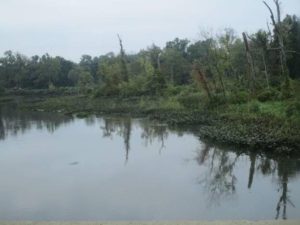
The Abbott Marshlands at Hamilton, Mercer County.
MONARCH BUTTERFLIES: Watch for monarch butterflies, “Danaus plexippus,” on their southern migration, to either Florida or, more likely, Mexico. This “super generation” are the great-grandchildren of last fall’s migrators and will make the complete migration. However, next year, they will begin northward, but will only make it so far, requiring three breedings to complete the journey north. Then, those great-grandchildren will become a “super generation,” making the entire journey south.
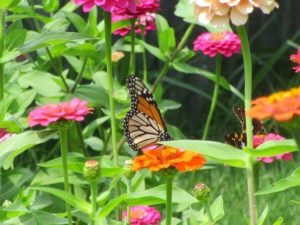
A monarch butterfly in my garden in August.
DRIVE-BY NATURALIST, BLACK VULTURES: I was driving to Princeton, Mercer County, to meet the lovely Pamela for breakfast and came across quite a scene on Route 27 in South Brunswick, Middlesex County – dozens of black vultures, “Coragyps atratus,” feeding on a dead deer. (As I mentioned last month, I do not recall seeing a black vulture locally until probably the 1990s. They are a southern species that has moved north.) Remember, nature is all around us, just keep an eye out for it.
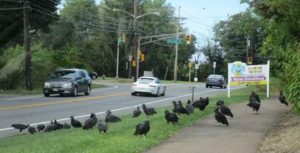
Black vultures on Route 27 in South Brunswick, Middlesex County.
DRIVE-BY NATURALIST, CHESTNUT TREES: As I was driving through the Pine Barrens around Helmetta, I noticed a Middlesex County Parks and Recreation pickup at the Jamesburg Park Conservation Area. I had to talk to naturalist Eric Gehring about a volunteer project, so I turned around and pulled over. Eric was on a mission with Les Nichols of the American Chestnut Foundation, looking for chestnut trees, “Castanea dentata,” in the Conservation Area. Since around 1900, the American chestnut has been plagued by a non-native and extremely invasive and potent fungal blight, “Cryphonectria parasitica,” – estimated to have crippled up to 4 billion chestnuts initially. American Chestnut blight affects the tree upward from where it infects it. The tree, then, is able to sprout again from roots, only to have those shoots, except for rare cases, infected. The Foundation seeks good specimens, hoping to create resistance in future chestnuts. Eric asked if I knew of chestnuts growing in these woods. Yes, at Swing Hill (which Eric already knew about) and at Big Tree. Into the woods, we headed – on my part unexpectedly, but I would rather walk the woods my family has walked for more than 100 years than do chores around the house – looking for specimens that may produce sought-after seeds in the future.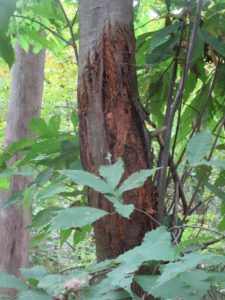
An American chestnut, in the Pine Barrens around Helmetta, infected with the fungal blight.
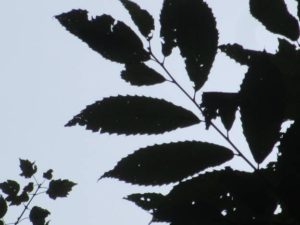
American chestnut leaves in silhouette – serrated with a surf wave-like pattern.
STINK BUGS: I had noticed one or two brown marmorated stink bugs, “Halyomorpha halys,” outside the house. This is an Asian species, apparently introduced accidentally in the Allentown, Pennsylvania, area in 1996. This week, I found one in the house on a blind in my living room — perhaps just the beginning of an infiltration for their overwintering. As a Rutgers University fact sheet says, “They enter houses through cracks in windows and the foundation and may be seen in large numbers during September and October.” If you go after one and, say, crush it, it will release an earthy odor. So, it is a nuisance, not a damaging bug to the house. However, it is a serious threat to crops. More information is available at https://njaes.rutgers.edu/stinkbug/. (As for crickets in the house, my $45,000 cricket deterrent project – that is the remodeling with the side benefit of keeping crickets out of the house – seems to be working. So far, only 8 crickets in the cellar and 2 in the living section of the house. A cacophony of crickets is beautiful music. A single cricket rubbing its legs in the wee hours like the fingernail scratching of a blackboard. While cleaning the garage, I may have discovered their last main intrusion route into the living section – through a crack/opening between garage floor and foundation.)
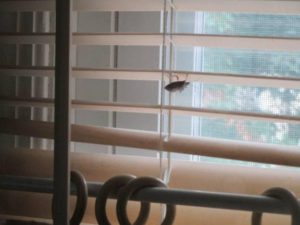
marmorated stink bug on a living room blind.
BIRD FEEDING: This is the first summer in years I have not gone all out feeding the birds in my yard. I miss watching them, but I saved quite a bit of money (because I use only sunflower hearts or kernels) and tried something new, letting the birds eat insects, serving as a natural pesticide. But the bird-feeder is back up and the birds are slowly discovering it. I am looking forward to beginning my day watching birds feed.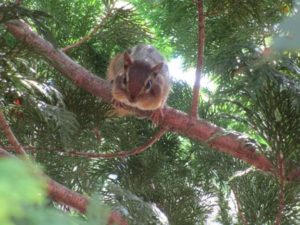
A chipmunk, “Tamias striatus,” in the yard.
FERRIS FARMS: Now that I am feeding the birds in my yard again, I stopped by my regular bird food supplier, Ferris Farms in East Brunswick, Middlesex County. I recall visiting Ferris as a youngster with my family. Mike Rutkowski and Tony Riccobono have always been friendly and helpful when I have asked gardening questions. See http://www.ferrisfarms.org/.
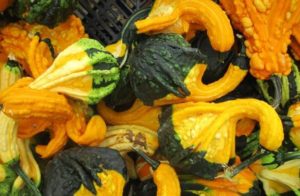
Gourds at Ferris Farms in East Brunswick, Middlesex County.

Pansies at Ferris Farms.
KITCHEN TABLE: The flower display on my kitchen table gets better and better. One, the Knock Out roses continued flowering. Two, the zinnias also continued blooming. Three, I learned the display looked better with the more zinnias that I used. Lastly, the gourds were the same as before but they seemed to be yellowing in color, making them more autumn-like. Of course, the antique, porcelain-top table adds to the country-ness of the display. On the down side, this rose bloom seems on its way out. (I have something up my sleeve, though: Grandma Annie Onda’s old kitchen table, with porcelain top and more ornate build, stands ready in my cellar to be moved upstairs to the kitchen.)
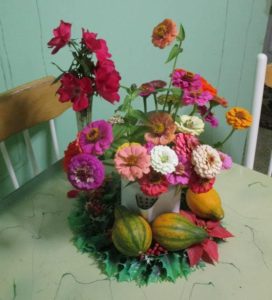
The kitchen table flower display.
ZINNIAS IN THE GARDEN: This week, my zinnias were distributed to the Helmetta Post Office, the lovely Pamela’s, and Jamesburg Dental Care (where I had my first dental appointment 55 years ago under Dr. Lew Goldstein). Butterflies continue to visit my zinnia patch.
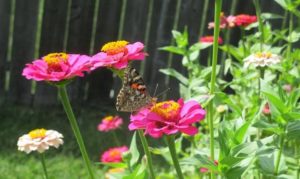
A painted lady, “Vanessa cardui,” in the zinnia patch.
HURRICANE JOSE, THE GOOD: Jose’s effects brought out sightseers to look at the roughness of the ocean. And I saw parasailing surfers taking advantage of the winds at the Atlantic Ocean at Sea Bright, Monmouth County.

A parasailing surfer in the Atlantic Ocean at Sea Bright, Monmouth County.
WEEDS IN THE YARD: When I see some kind of vegetation popping up in the yard, I let it grow to observe it. So, year after year, pokeweed, “Phytolacca americana,” pops up, one plant along my driveway, another in my garden. Here is an interesting article on this complicated plant, http://nadiasyard.com/our-native-plants/american-pokeweed/.
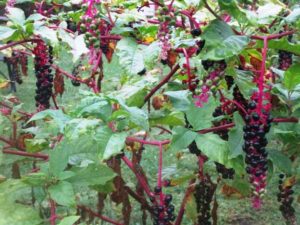
Pokeweed in the garden.
MONMOUTH CONSERVATION FOUNDATION: A shout-out to the Monmouth Conservation Foundation, a not-for-profit land preservation group in Monmouth County, as it celebrates its 40th anniversary. Over the 40 years, it has helped save more than 22,000 acres of open space. (The Foundation recently contracted me to write two articles – one on the group’s origin and another on Monmouth County wildlife — for one of its upcoming publications.)
OCEAN TEMPERATURES: Atlantic Ocean temperatures on the New Jersey coast were about 69 degrees to 74 degrees on the weekend of September 23-24.
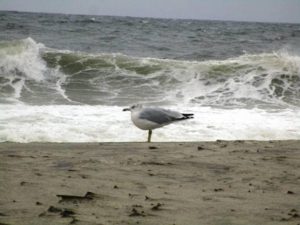
A gull at the Atlantic Ocean beach at Sea Bright, Monmouth County.
SUNRISE/SUNSET: For September 24, Sunday, to September 30, Saturday, the sun will rise about 6:50 a.m. and set about 6:45 p.m. For October 1, Sunday, to October 7, Saturday, the sun will rise about 6:55 to 7 a.m. and set about 6:30 to 6:40 p.m.
THE NIGHT SKY: The next full moon is the Full Harvest Moon October 5, Thursday.
WEATHER: The National Weather Service forecasting station for the area is at http://www.weather.gov/phi/.
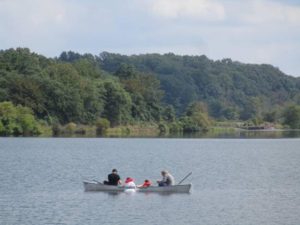
“Jamesburg Lake,” or more properly “Lake Manalapan,” on the boundary of Monroe and Jamesburg, Middlesex County, is about 35 to 40 acres. On the Outer and Inner Coastal Plains, there are few, if any, natural bodies of water. So, Jamesburg Lake on the Inner Coastal Plain is formed by the damming of Manalapan Brook.
Joe Sapia, 60, is a lifelong Monroe resident. He is a Pine Barrens naturalist and an organic vegetable-fruit gardener. He gardens the same backyard plot as did his Italian-American father, Joe Sr., and his Polish-immigrant, maternal grandmother, Annie Poznanski Onda. Both are inspirations for his food gardening. Joe is active with the Rutgers University Master Gardeners/Middlesex County program. He draws inspiration on the Pine Barrens around Helmetta from his mother, Sophie Onda Sapia, who lived her whole life in these Pines, and his Grandma Annie. Joe’s work also is at @JosephSapia on Twitter.com, along with Facebook.com on the Jersey Midlands page.
Article and photos by Joe Sapia
Note: The yard references are to my house in the section of Monroe between Helmetta and Jamesburg in South Middlesex County. My yard is in a Pine Barrens outlier on the Inner Coastal Plain, the soil is loamy, and my neighborhood is on the boundary of Gardening Zones 6b (cooler) and 7a (warmer). Notes and photographs are for the period covered, unless otherwise noted.
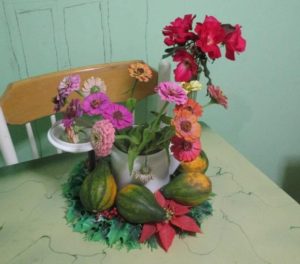
My kitchen table display gets better and better: Gourds, which mysteriously appeared in the garden, are added to the display of zinnias and Knock Out roses on the antique porcelain-top table.
BIG SKY COUNTRY, EMLEY’S HILL: I was driving through one of my favorite places in the Midlands, rural Western Monmouth County. I stopped at Upper Freehold’s Emley’s Hill, part of the cuesta geological formation that divides the Outer and Inner Coastal Plains. Generally, east of this hilly formation drains directly to the Atlantic Ocean, while west of the cuesta drains to the Raritan River. Emley Hill, though, is on a spur of the cuesta dividing the drainages of the Raritan River and the Delaware River. Because it is a hilly rural area at about 140 feet above sea level with lower surrounding farmland, there are beautiful big-sky views. Emley’s Hill is at the intersection of Emley’s Hill Road and Burlington Path Road.
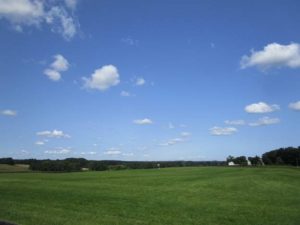
Looking east from Emley’s Hill in Upper Freehold, Monmouth County.
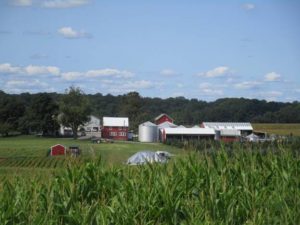
Looking north from Emley’s Hill at the Bullock Farms, http://www.bullockfarms.com/.
WILD OUTDOOR EXPO: The New Jersey Wild Outdoor Expo is an annual event, held at the Colliers Mills Wildlife Management Area in Ocean County. It includes information on environmental issues and parks, hunting, fishing, trapping, other recreational use of the outdoors, and so on.
This year’s expo, held on Saturday and Sunday, September 9 and 10, was sponsored by the state Department of Environmental Protection’s Division of Fish and Wildlife, Division of Parks and Forestry, and Forestry Services, along with the Conserve Wildlife Foundation of New Jersey.
Colliers Mills WMA is the almost 13,000 acres of open space — Pine Barrens forest, fields, waterways, and bodies of water — behind the Six Flags/Great Adventure amusement area. Outside of New Jersey, WMAs are referred to as “game lands.” In New Jersey, WMAs are shared by hunters and other recreational outdoors people.
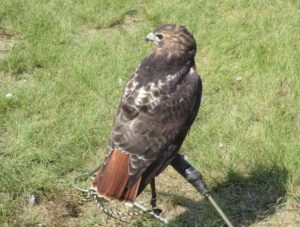
Red-tailed hawk, “Buteo jamaicensis,” on display at the Expo. Note the reddish tail giving the hawk its name. Red tails are commonly seen, soaring above, or commonly heard, calling in a wheezy-sound way.
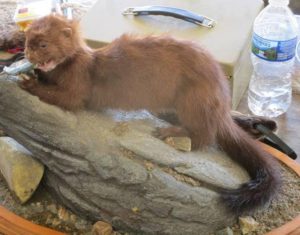
A mounted mink, “Mustela vison.” They are around, but the only two I have seen were both roadkills in recent years in the Pine Barrens around Helmetta.
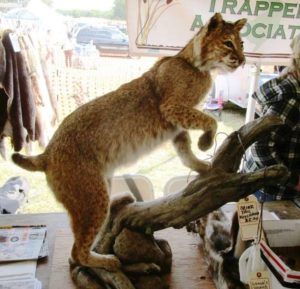
A mounted bobcat, “Lynx rufus.” I describe them as having a dog-like body with a cat’s head. I would love to see one in the wild. The state lists the bobcat as “endangered,” or in immediate peril of surviving.
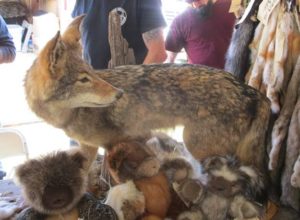
A mounted coyote, “Canis latrans.” Note the dog-like body, but pointy fox-like nose and ears. From 2014 to 2016, I worked an overnight shift near the Metropark train station in Woodbridge, Middlesex County, and I would occasionally see a coyote. One night, an ambulance was on the other side of the woods, yipping its siren. The coyotes started up, yipping away. Smart animals – I once read a suggestion if coyotes had opposing toes, they probably would run the world.
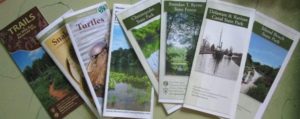
Brochures from the Expo.
FALLING ACORNS: I was driving one of the paved roads through the Jamesburg Park Conservation Area in the Pine Barrens around Helmetta and came across outdoorsman Art Utter, who lives nearby in Spotswood. Art was gathering acorns to use as hunting bait around his deerstand. While we were talking, I was listening to and dodging falling acorns. Earlier, Art got conked on the head by one and it drew blood. These things looked massive. Some might say these acorns suggest a severe winter ahead, with the acorns providing animals with food. I do not think it is a good predictor of anything. The only thing I got out of it was that it seemed as though acorns were falling steadily and they were big.
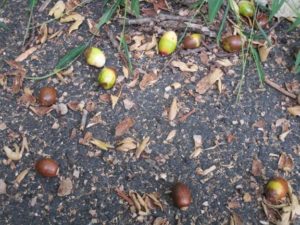
Acorns litter a road in the Jamesburg Park Conservation Area in the Pine Barrens around Helmetta.
IN THE GARDEN: I got tired of looking at the tangle of cucumber and cantaloupe plants that did not produce one usable item this year. So, I mowed them down, along with the tomatillos and gourds, both of which I did not plant. So, now, I look forward to fall lettuce, which is growing nicely, and carrots.
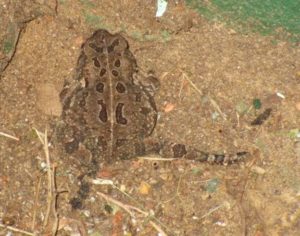
I came across this toad, genus “Anaxyrus,” while cutting the lawn.
THE FLOWERING YARD: The zinnias and Knock Out roses continue to bloom, although the zinnias may have slowed down – perhaps because of powdery mildew and leaf spot. But the Knock Outs seem to be flourishing.
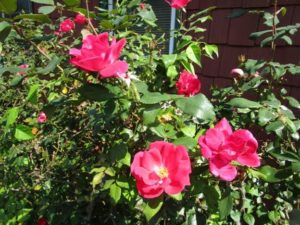
Knock Out roses continue to bloom nicely – even flourishing.
OUT-OF-SEASON FLOWERING: Occasionally, plants bloom out of season. In the past, I remember seeing sheep laurel, “Kalmia angustifolia,” blooming in the fall in the Pine Barrens around Helmetta, when its normal bloom is May and June. Maybe an out-of-season bloom was caused by temperatures and sunlight replicating normal bloom times. Whatever the reason, the flowering quince bush in my yard was actually flowering. Normal flowering would be in the spring.
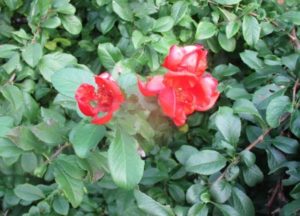
Flowering quince blooming out of season.
BIZARRE EXPERIENCE IN THE YARD: The flowering quince was unusual, but not bizarre. The bizarre experience happened a day earlier, when I was cutting the front yard grass. First, I notice a rabbit, “Sylvilagus floridanus,” watching me from a few feet away on the other side of the hedges. As I have mentioned, if I go about my own business, the rabbits and butterflies allow me to get close. As I was cutting the grass along the street’s edge, I noticed something embedded in the ground where I had just mowed – a 20-gauge, loaded shotgun shell! If I cut that open when I was mowing, I could have sprayed hundreds of pellets. Fortunately, it was intact, but bent, probably having been run over by a vehicle. In the old days, I could have asked any of a number of hunters in the neighborhood what to do. But hunting is becoming less popular, so less available sources. Although it was probably remote I could set off the primer and powder, I did not want to take a chance. So, I called Monroe Police and gave it to responding Officer Bob Bennett with whom I had a great conversation about the local woods. (Officer Bennett opened the conversation, asking if I was the guy…. Uh, oh, a police officer asking if I was the guy! Actually, he asked if I was the guy who posts nature photographs on the local Facebook page. Guilty, Officer. I mean, Yes, Officer.) As for the shotgun shell, who knows where it came from. My friend, the rabbit, disappeared. Was it warning me about the shell?
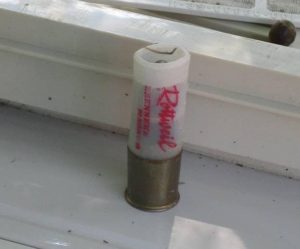
The shotgun shell.
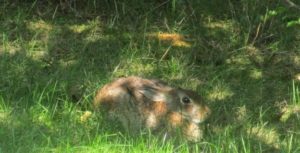
My rabbit friend. Was it warning me about the shotgun shell?
FLOWERING HIGHTSTOWN: One of my regular stops is the Hightstown Diner, where Kathy and George Antonellos have been great hosts over the decades in their 1941 diner. What I notice when I visit the diner is the flowers in this quaint, historic Mercer County town. So, I walked about, shooting photos of them. (If you like South Jersey-Philadelphia scrapple, the Hightstown Diner has it – one of the northernmost locations where scrapple can be found. Me, I love scrapple!)
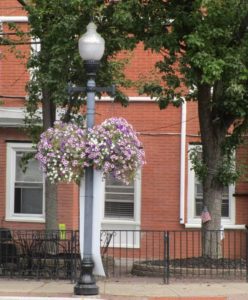
The corner of Mercer Street (Route 33) and Rogers Avenue in Hightstown, Mercer County.
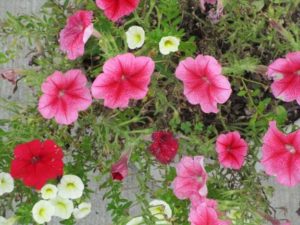
Along Mercer Street (Route 33) in Hightstown, Mercer County.
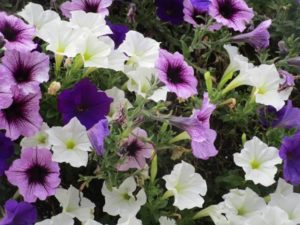
Flowering Hightstown.
DRIVE-BY NATURALIST, A GREAT EGRET: As I was driving home from Hightstown, I crossed the Millstone River, the boundary of East Windsor, Mercer County, and Cranbury, Middlesex County. There, I noticed a perched great egret, “Ardea alba.” Keep an eye out for nature. It is all around us.
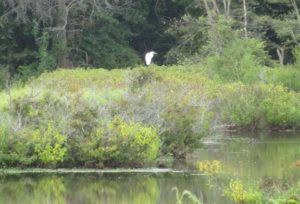
A great egret on the Millstone River. Here, the river is the boundary of East Windsor, Mercer County, and Cranbury, Middlesex County.
OCEAN TEMPERATURES: Atlantic Ocean temperatures on the New Jersey coast were about 72 degrees Friday, September 15.
SUNRISE/SUNSET: For September 17, Sunday, to September 23, Saturday, the sun will rise about 6:40 to 6:45 and set about 6:55 to 7:05. The fall equinox of nearly equal daylight and sunlight is September 22, Friday. For September 24, Sunday, to September 30, Saturday, the sun will rise about 6:50 a.m. and set about 6:45 p.m.
THE NIGHT SKY: The new moon is September 20, Wednesday. The next full moon is the Full Harvest Moon October 5, Thursday.
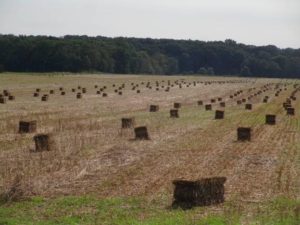
Harvest time it is. Here, hay being harvested on a farm in Cranbury, Middlesex County.
WEATHER: The National Weather Service forecasting station for the area is at http://www.weather.gov/phi/.
Joe Sapia, 60, is a lifelong Monroe resident. He is a Pine Barrens naturalist and an organic vegetable-fruit gardener. He gardens the same backyard plot as did his Italian-American father, Joe Sr., and his Polish-immigrant, maternal grandmother, Annie Poznanski Onda. Both are inspirations for his food gardening. Joe is active with the Rutgers University Master Gardeners/Middlesex County program. He draws inspiration on the Pine Barrens around Helmetta from his mother, Sophie Onda Sapia, who lived her whole life in these Pines, and his Grandma Annie. Joe’s work also is at @JosephSapia on Twitter.com, along with Facebook.com on the Jersey Midlands page.
Article and photos by Joe Sapia
Note: The yard references are to my house in the section of Monroe between Helmetta and Jamesburg in South Middlesex County. My yard is in a Pine Barrens outlier on the Inner Coastal Plain, the soil is loamy, and my neighborhood is on the boundary of Gardening Zones 6b (cooler) and 7a (warmer). Notes and photographs are for the period covered, unless otherwise noted.
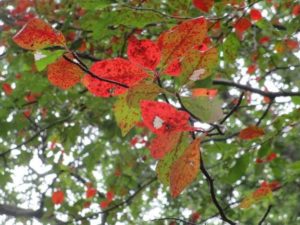 A black gum, “Nyssa sylvattica,” changes color at Cranberry Bog in the Pine Barrens around Helmetta.
A black gum, “Nyssa sylvattica,” changes color at Cranberry Bog in the Pine Barrens around Helmetta.
CHANGING COLORS IN THE PINE BARRENS AROUND HELMETTA: Black gum trees, ““Nyssa sylvattica,” are obvious with their leaves changing colors for the season. “Fall foliage,” meaning the changing colors as colder weather approaches, is a misnomer, because, here, in the Pine Barrens around Helmetta, changing colors are noticeable beginning about July 15 to 31. I look for the peak of the coloring October 13 in wet areas and October 20 in dry areas, but, really, it is impossible to pinpoint a peak. If there is even a peak, because there may not be a uniform turning of colors.
“OPIENKI” MUSHROOMS, PINE BARRENS AROUND HELMETTA: As I drove a paved road through Jamesburg Park today, I saw a car parked at the woods and a woman at the car. She wore yoga pants, a short-sleeve pullover shirt, and sneakers, pants untucked — not really dressed as a woodswoman. So, I took a guess at what she was doing.
Mushrooms? I asked.
She said yes.
What kind, honey mushrooms?, I said.
The woman — Lana, who lived a few miles away from the site — said she did not know the name to tell me. Then, I noticed what sounded to be an Eastern European accent.
“Opienki”? I asked.
Yes, she smiled. How did you know that name?
A grandmother from Poland, I said.
Lana is from the Ukraine. She was picking edible mushrooms of the genus “Armillaria,” known by Polish people as “opienka” singular and “opienki” plural. “Pien” means stump in Polish and these mushrooms grow along the stumps of dead oaks. Hence, they also are known as “stumpies” — and “tan and yellow stumpies” because of their color and, of course, where they are found. But the general public probably would know them best by their common name, “honey mushrooms.”
Lana had bags filled with mushrooms in her car. (See the photos, which she let me take.)
Journalisticly, I am publishing this to inform people. In a neighborly way, I am hesitant to publish this because PICK THE WRONG MUSHROOM AND, AT BEST, YOU WILL GET SICK, AND, AT WORST, YOU WILL DIE.
I am 60-years-old and have been in these woods my whole life, and have heard stories from them going back another 50 or 60 years to when my maternal family settled here, and I will confidently pick ONLY ONE mushroom in the Pine Barrens around Helmetta: opienka. In the Jersey Midlands as a whole, I will confidently pick ONLY TWO: the second one, a morel, which I am familiar with on the Piedmont — say, at such areas as Princeton and Sourland Mountain.
I am “somewhat confident” to pick two more. But I made it to 60 and “somewhat confident” does not cut it. Remember the adage: There are bold mushroom pickers and there are old mushroom pickers. There are no old AND bold mushroom pickers.
If one must pick mushrooms, three bits of advice, even for the experienced picker: One, know how to call emergency responders, telephone 911; two, the telephone number of New Jersey Poison Control, 800-222-1222; and three, save one mushroom, perhaps on your kitchen counter, so doctors know the mushroom one ate.
I said good-bye to Lana, warning her of ticks, which can pass along disease such as Lyme, and chiggers, which will get one itching, beginning about 36 hours after leaving the woods, and scratching like crazy for days. (Me, man who got chiggers a week ago, here, in the Pine Barrens around Helmetta. Me, stupid man because I was not thinking and did not avoid grassy areas.)
(Dedicated to Grandma Annie Poznanski Onda, born 1885 in Poland, died 1972 in the Pine Barrens around Helmetta. And a big thank you to Ralph “Rusty” Richards, woodsman extraordinaire of the Pine Barrens around Helmetta, who continues to be a local woods mentor to me.)
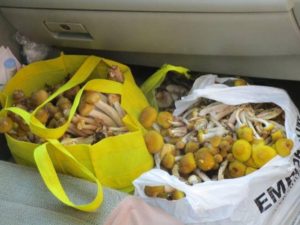
Lana’s “opienki” mushrooms in the Pine Barrens around Helmetta.
ALSO IN THE PINE BARRENS AROUND HELMETTA: Look for fall bloomers, such as asters. Joe Pye weed, “Eutrochium purpureum,” remains blooming – and will do so until about October. Queen Anne’s lace, “Daucus carota,” continues blooming to about November. The seed heads of punks, or cat-tails, genus “Typha,” were fluffing as summer passes.
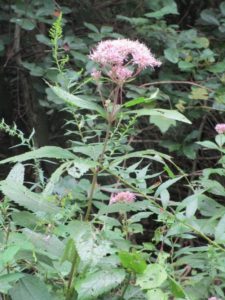
Joe Pye weed in bloom near the Ditch in the Pine Barrens around Helmetta.
CHIGGERS IN THE PINE BARRENS AROUND HELMETTA: I did a brief hike Friday, Sept. 1, and began itching around Sunday morning – chigger bites! Fortunately, I did not get a bad case, a bit of itching here and there on my legs. I first encountered chiggers, here, in about 2004. Some view chiggers as a Southern species moving north; Others will say we already had them up here. I knew of chiggers from hiking in the Pine Barrens down in South Jersey. The bottom line is they itch! So, I will scratch for a few days, then life will go on until the next round of chiggers. (A tip: Avoid grassy areas such as those I walked in on my hike. I just was not thinking.)
MA, GRANDPA, AND THE LOCAL PINE BARRENS: Perhaps I was not thinking of chiggers on Sept. 1 because my mind was elsewhere. Earlier that day, I had mailed in a donation to my church, Holy Trinity Roman Catholic Church in Helmetta, and a request for a Mass to be said in Grandpa Mike Onda’s honor October 11– the 100th anniversary of his death in Helmetta from tuberculosis at 35–years-old. He left a 32-year-old widow, Annie Poznanski Onda, and three children 5-years-old and younger. One of those children was my mother, Sophie Onda Sapia, who was 3 when her father died. Her only memory of her father in later years was of her with him at Shekiro’s Pond in Helmetta. September 1 was the 22nd anniversary of Ma’s death at 81 in 1995. On this anniversary, I visited Shekiro’s Pond.
PESTS IN THE YARD: Neighbor Tom DeRose contacted me on the night of Labor Day, wanting to show me something in his yard. So, in the dark with flashlights, Tom and I were looking into a hole – perhaps big enough to shove in a few golf balls – of yellow jacket wasps. Ugh! They have scared me since I was a kid playing Army in this same neighborhood with Eddie Kasubinski. I pointed down the street at “The Swamp,” where Eddie and I got attacked – not by an opposing army, but by “yellow jacks.” I ran up the street crying. My father heard me, rushed into the backyard, saw the yellow jacks attacking me, grabbed my Army jacket, which had yellow jacks in it, and threw it aside. A number flew out of the jacket. I had got stung twice. Yellow jacks can be aggressive and multiple stingers. So, I advised Tom to stay away from his side yard until the cold weather sets in or spray a pesticide into the hole.
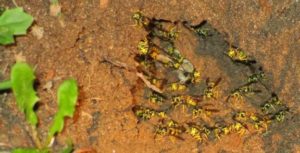
The yellow jacket nest in Tom DeRose and Trisha Miller DeRose’s side yard.
LAURINO FARMS: I was out in Monmouth County and stopped by Laurino Farms on Route 537 (between Laird and Swimming River Roads) in Colts Neck. There, I picked up a favorite of mine, white peaches, along with a jar of cranberry preserves. A shout out to Bobby Laurino, whom I saw briefly – personally, Bobby has patiently answered my gardening questions and he is an inspiration for me growing zinnias this year. And, more importantly, a shout out to Bobby for what he does for feeding the needy, including helping the Soul Kitchen restaurants (www.jbjsoulkitchen.org) in Red Bank and Toms River, founded by rock and roll star Jon Bon Jovi and his wife, Dorothea Bongiovi, who live in Middletown, Monmouth County, to support the needy. For example, Laurino provides space at his farm for Soul Kitchen to grow food organically. Dorothea said, “Bobby is an amazingly generous person, not only with his contribution of land to the Soul Kitchen so we could raise our own vegetables, (but) he is generous with his time, his knowledge, his spirit. I am not sure if all farmers are as optimistic as Bobby, but he has a positive can-do attitude that maybe all farmers need. Farming is an unbelievably difficult life, with many uncontrollable variables: temperature, rain, sun, insects (Bobby does not use pesticides), animals. I have enormous respect for anyone who grows food for others.” (And a shout out to Dorothea, who handles herself with class and humility. Over the summer, Dorothea received a Volunteer Leadership Award in the New Jersey State Governor’s Jefferson Awards for Public Service for her work with Soul Kitchen. “I was very surprised and humbled by the Jefferson award,” Dorothea said.)
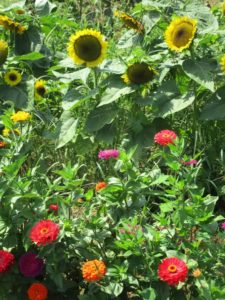
Zinnias and sunflowers at Laurino Farms in Colts Neck, Monmouth County.
DRIVE-BY NATURALIST, “BIDENS” FLOWERS: Although I know the yellow flowers of the genus “Bidens” are adorning unplowed farmland and disturbed areas, it still amazes me when I come across fields of these flowers. I was driving in southern Monroe and came across this batch, next to acres of soybeans.
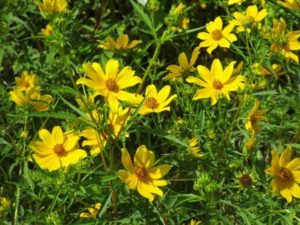
Yellow flowers of the genus “Bidens” in southern Monroe.
IN THE YARD AND GARDEN: The zinnias and Knock Out roses continue to bloom earnestly.
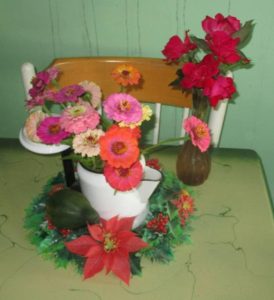
Zinnias, Knock Out roses, and a gourd, all from the my yard or garden, decorate the antique porcelain-top table in my kitchen. One of Ma’s old coffeepots is used as a vase.
MY BELOVED ZINNIAS: While still flowering wonderfully, the zinnias appear to have contracted powdery mildew. So, I will be dealing with this.
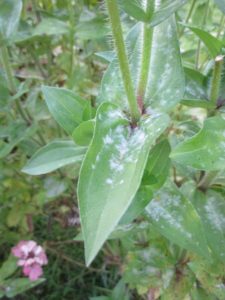
Apparently powdery mildew on the zinnias.
IN THE GARDEN: My summer crop, except for the zinnias, was a disaster. The sweet corn was undeveloped, probably because of too much rain and I should have planted in a bigger block to foster pollination, but it was harvestable and tasty. Too much rain translated into no cucumbers, no cantaloupe. Very few tomatoes, because something ate the tops off the plants.
MECHKOWSKI FARM: Timmy Mechkowski farms in Helmetta. He reported good crops of sweet corn, beets, stringbeans, carrots, broccoli, cabbage, and onions. “Tomatoes were decent until the end, when we starting getting the rain.” Timmy reported a bad year for peppers, potatoes, and blackberries. The Mechkowski farm is one of my favorite places.

Sitting on the front porch of his house, Timmy Mechkowski goes over his planting list.

Timmy Mechkowski’s dog, Abby, probably the most beautiful and most gentle dog I have ever met.
NAVESINK RIVER: The Navesink River drains about 95 square miles in the Red Bank area of Monmouth County. It abuts the hilly geological formation that separates the Inner and Outer Coastal Plains. The river sits on the Outer Coastal Plain side. These photos were taken downstream of the Ocean Bridge from the Middletown side. The bridge connects Middletown and Rumson. The Navesink River is one of my favorite places in the Jersey Midlands.
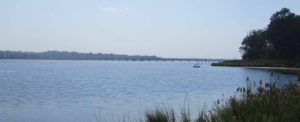
On the Navesink River, looking toward the Oceanic Bridge connecting Rumson, left, and Middletown, right.
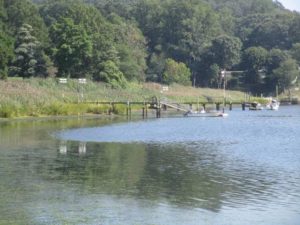
Along the Navesink River.
DRIVE-BY NATURALIST, GREAT BLUE HERON: As I was leaving the Navesink River, I noticed a great blue heron, “Ardea Herodias” – a large bird I am in awe of.
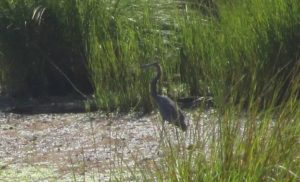
The great blue heron along the Navesink River.
BIG SKY COUNTRY, MONROE TOWNSHIP: As the Jersey Midlands continue to develop, there is more a loss of big sky views. But the area between the Applegarth and Wyckoff’s Mills sections of Monroe is still a holdout. Here, there are wonderful views over soy bean fields and cornfields.
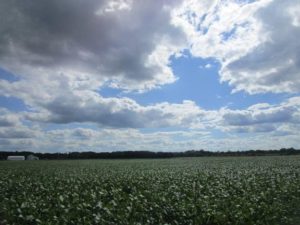
Between Monroe’s Applegarth and Wyckoff’s Mills sections, looking over a soybean field toward Route 33.

Between Monroe’s Applegarth and Wyckoff’s Mills sections, looking toward Cranbury, with corn growing to the right and soybeans to the left.
THE FLIP SIDE OF BAMBI: I have published photographs of beautiful deer in nature. I need to point out the flip side: deer on farmland and in garden. Years ago, I was talking to a farmer who grew corn on the state’s Assunpink Wildlife Management Area in western Monmouth County. The farmer paid no rent, but he had to leave a percentage of his crop to feed wildlife. The way I recall the story: “The problem is,” the farmer said, “the deer don’t know which 75 percent is mine and which 25 percent is theirs.” As Jersey Midlands nature writer John McPhee has written, “Deer, in my opinion, are rats with antlers, roaches with split hooves, denizens of the dark primeval suburbs. Deer intensely suggest New Jersey.”
OCEAN TEMPERATURES: Atlantic Ocean temperatures on the New Jersey coast were in the range of about 69 to 72 degrees during the weekend of September 9-10.
SUNRISE/SUNSET: For September 10, Sunday, to September 16, Saturday, the sun will rise about 6:35 to 6:40 a.m. and set about 7:10. For September 17, Sunday, to September 23, Saturday, the sun will rise about 6:40 to 6:45 and set about 6:55 to 7:05. The fall equinox of nearly equal daylight and sunlight is September 22, Friday.
THE NIGHT SKY: This week, in the pre-sunrise sky, I saw the constellation Orion for the first time this season – Colder weather is coming with the winter constellations. The moon is waning after the September 6 full moon. The new moon is September 20, Wednesday. The next full moon is the Full Harvest Moon October 5, Thursday.
WEATHER: The National Weather Service forecasting station for the area is at http://www.weather.gov/phi/.
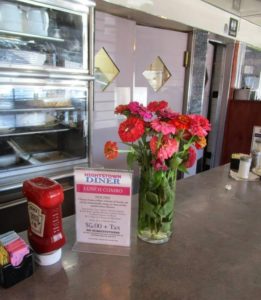
Joey’s zinnias at the Hightstown Diner, in Hightstown, Mercer County.
Joe Sapia, 60, is a lifelong Monroe resident. He is a Pine Barrens naturalist and an organic vegetable-fruit gardener. He gardens the same backyard plot as did his Italian-American father, Joe Sr., and his Polish-immigrant, maternal grandmother, Annie Poznanski Onda. Both are inspirations for his food gardening. Joe is active with the Rutgers University Master Gardeners/Middlesex County program. He draws inspiration on the Pine Barrens around Helmetta from his mother, Sophie Onda Sapia, who lived her whole life in these Pines, and his Grandma Annie. Joe’s work also is at @JosephSapia on Twitter.com, along with Facebook.com on the Jersey Midlands page.
Article and photos by Joe Sapia
Note: The yard references are to my house in the section of Monroe between Helmetta and Jamesburg in South Middlesex County. My yard is in a Pine Barrens outlier on the Inner Coastal Plain, the soil is loamy, and my neighborhood is on the boundary of Gardening Zones 6b (cooler) and 7a (warmer). Notes and photographs are for the period covered, unless otherwise noted.
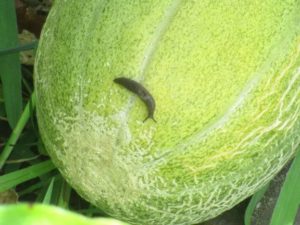
This photograph – that of a slug on a cantaloupe — basically sums up my garden’s summer fruit and vegetable crop. Slugs like moisture. And it was just a wet season.
GARDEN VOICES, NO.1: “It has simply been too wet for most things,” said Bob Eriksen, a retired biologist with the state Department of Environmental Protection who gardens in Warren County, just outside of the Jersey Midlands. “I have had groundhog issues in our garden, as well as deer. The deer are early — when the mulberries are hitting the ground, they spend time poking around our yard nibbling on everything. The groundhogs have been a major issue, eating everything from tomatoes and peppers to petunias. I have removed eight, so far, and believe there are still at least two more. I did not trap any last summer, but the summer before I caught nine.”
IN THE GARDEN: Aside from the zinnias and Knock Out roses, both of which continue to produce nicely, I pretty much have given up on the rest of the summer crop. Not one cucumber! And I fear not one cantaloupe will ripen properly. But the fall crop of carrots and lettuce, planted in early August, are coming up nicely.

Here comes the fall lettuce crop.
GARDEN VOICES, NO. 2: Paul Migut, a childhood friend and one of my gardening mentors, checked in from South River, Middlesex County. Paul, who is in his early 60s, has been food gardening since childhood: “I’d say this wasn’t the best of year for the vegetable garden. I’d say 3 out of 5.
Bush beans producing about 20 percent of previous month. Some plants drying up, branches showing signs of ‘old age’ (brown, brittle). Pickles still producing, but much slower, and also appear to be drying despite watering at 6:30am. Zucchini, a total waste as borers devoured the stalks.
Eggplants producing, but not as plump as prior years. Rutgers tomatoes small, (good color and that Jersey flavor!). Yellow (acid-free) producing fairly well, though appear a bit delicate with signs of spots, imperfections, but rather juicy. Radishes done. And the ‘mistake’ purchase of turnip (Purple Top White Globe, ‘Brassica rapa’) are still leafy, bushy, and still getting bigger — some over 4 to 5 inches diameter. Pulled more weeds than crops yesterday! Now to the house- rotate use of de-humidifier water between hydrangea in front of house and to refill backyard birdbath.” Paul is a great food gardener, making a not-so-good food garden year still a good year.

Circa late 1960s, Monroe Township – Paul Migut with an 8-horsepower roto-tiller at the huge garden of his uncle, Stanley “Pon” Ceslowski.
AROUND THE YARD: I was harvesting zinnia in the backyard garden when a large shadow passed over the backyard. I looked up and only a few yards away flew two turkey vultures, “Cathartes aura.” Usually, I see them soaring, riding the currents, rather than being nearby. I did not smell any dead animal for them to scavenge. So, perhaps they were perched nearby and I startled them.
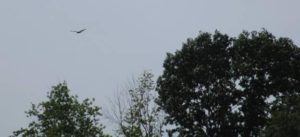
This turkey vulture flew off while I was in the backyard.
CATBIRDS AND CAT: I was doing some outside painting when a ruckus interrupted me. About four catbirds, “Dumetella carolinensis,” converged in the shrubbery behind me, next to the street. Underneath the hedges was the neighborhood cat, feasting on what was once part of the catbird clan.
DRIVE-BY NATURALIST: I was driving across the Swimming River Reservoir on the boundary of Holmdel and Colts Neck in Monmouth County and noticed two great egrets, “Ardea alba,” so I stopped and shot photos of one with Canada geese, “Branta canadensis.”
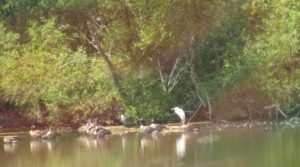
A great egret and Canada geese on the Swimming River Reservoir in Monmouth County.
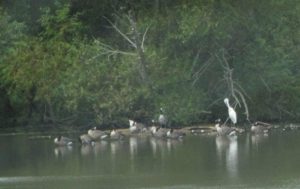
Another view of the great egret and Canada geese on the Swimming River Reservoir.
SEA BRIGHT BEACH: The Atlantic Ocean had a bit of a chop on the afternoon of Tuesday, August 29, at Sea Bright, Monmouth County, the surf tussled by the wind — sustained at about 10 to 13 knots per hour (a “gentle breeze” to “moderate breeze”) and gusts up to 14 to 19 KPH (“moderate breeze” to “fresh breeze”) about 3:30 to 4 o’clock, all out of the East Northeast, as recorded at nearby Sandy Hook. (Honestly, I thought the wind was blowing harder at Sea Bright.) Flags were extended, the surf rough, and foam, created by an agitated ocean, covered the surf line. Plus, it was raining. …But it was OK, that is what nature is about. And I had the beach to myself!
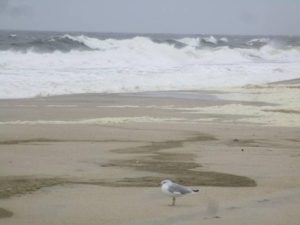
On this day at the beach in Sea Bright, Monmouth County, whitecaps were on the Atlantic Ocean, the surf churned, and the agitated ocean produced foam covering the surf line. It was kind of a day for the birds – or beach naturalists.
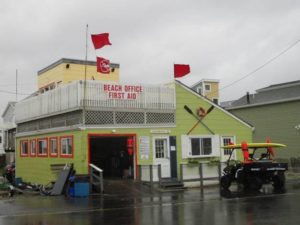
Flags at the Sea Bright Ocean Rescue Headquarters show the force of the wind.
SEPTEMBER AT THE SHORE: The traditional Jersey Shore summer season is the Memorial Day Weekend to the Labor Day Weekend. So, Labor Day Monday, September 4, would mean it is all over. Wrong! Remember the Shore secret, September is the best month at the Shore – less people, warm air and Atlantic Ocean temperatures, soft sunlight. But be extra careful if going into the ocean when lifeguards are not on duty.

2013, September, at the Atlantic Ocean in Asbury Park.
YELLOW FLOWERS IN THE FIELDS: The “Bidens” genus flowers are blooming nicely on unused farmland and disturbed areas. I vaguely remember hearing a story this yellow flower is not native to New Jersey, first being discovered in the state along railroad tracks at Camp Kilmer near New Brunswick in the post-World War II or Korean War years, suggesting it was transported from its native southern United States via railroad. I am going to take a guess and identify the species as “aristosa.” (But this historical and botanical information would have to be verified.) Basically, it is a weed — although a colorful one that brightens fields this time of year.
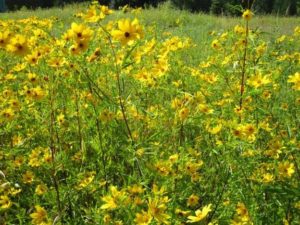
“Bidens” wildflower growing in South Brunswick, Middlesex County.
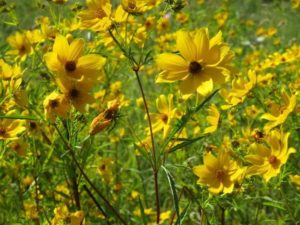
More of the “Bidens” wildflower in South Brunswick, Middlesex County.
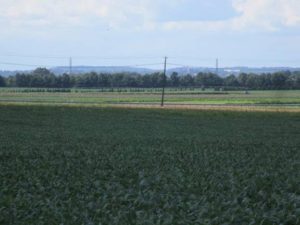
Where the generally flat Coastal Plain meets the rolling hills of the Piedmont — In the foreground is a soybean field on the boundary of Cranbury and Plainsboro in Middlesex County on the Coastal Plain, or more specifically the Inner Coastal Plain. In the distance haze are the rolling hills of Princeton, Mercer County, on the Piedmont. The Jersey Midlands are filled with stories of geology, flora, fauna, and, especially if we turn off outside lighting, the Night Sky.
COASTAL PLAIN BODIES OF WATER: Between the soybean field and the hilly ground in the previous photograph is a 23-acre pond in Plainsboro. The name on the sign, “Mill Pond Park,” says a lot. Its name suggests the pond was built, by damming Cranbury Brook, to form a power source for a mill. Most, if not all, bodies of water on the generally flat Coastal Plain are human-made.
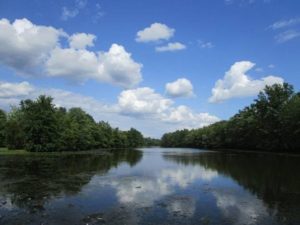
Plainsboro’s Mill Pond
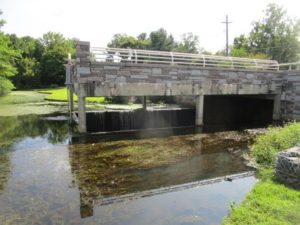
The dam that holds back Cranbury Brook to form Plainsboro’s Mill Pond.
A TALE OF TWO DEER: As I drove through Thompson Park in Monroe, I noticed a white-tail deer, “Odocoileus virginianus,” buck. He had a beautiful 10-point, velvet-covered rack. He was not free. Instead, he was confined behind a fence as part of the park zoo. Later that day, I saw another beautiful buck, this one on a section of Sourland Mountain in Montgomery, Somerset County. He roamed freely in a rural area of woods and farmland. But how free is “free”? Assuming the status of the two deer does not change, the zoo buck will be safe during hunting season, but the Sourland Mountain deer may wind up as someone’s meal or trophy.
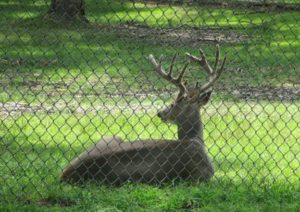
The Thompson Park Buck
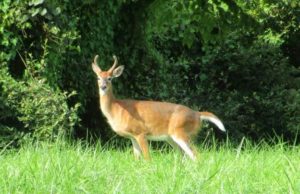
The Sourland Mountain buck.
FOR LAWN LOVERS, BLEGGGGGHHHH!: As you probably know, I dislike trophy lawns – basically, non-native wastelands filled with pollutants. Better to go green – go organic, go with native plants instead of a lawn, create high-grass wildlife patches, grow vegetables, or plant annual flowers that attract pollinators. But if you must…. Now is the correct time to seed lawns – as early in September as possible, not later than mid-September. This time of year provides for good seed growth, while competitive weeds are no longer growing. See the Rutgers University Cooperative Extension Service “Seeding Your Lawn” fact sheet, https://njaes.rutgers.edu/pubs/fs584/.
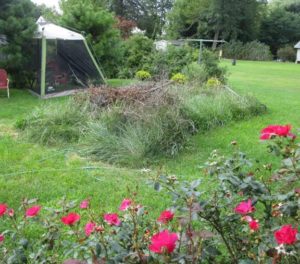
A wildlife patch in my neatly kept, but un-trophy-like, lawn.
GARDEN VOICES, NO. 3: Priscilla “Peppy” Bath, who gardens in Hamilton, Mercer County, knows about my quest to eliminate lawn in favor of garden. She checked in from vacation in Germany’s Black Forest. “I took a walk this morning and the house across from my hotel has no grass at all, just a beautifully maintained garden. It has flowers and vegetables, no weeds. Knock Out roses, cosmos, mountain pink, lots of lettuce, green beans, tomatoes, zucchini, and bare spaces where other already-harvested vegetables were. Perhaps this is what you are striving for.”
LEECHES: Sophie Onda Sapia used to tell me about leeches when she was a kid in the Pine Barrens Around Helmetta, where she lived all her 81 years, from 1913 to 1995. Ma said sometime one or more would latch onto one when swimming in the local waters. I have been around these waters all my 60 years – blessed to still walk afield where my maternal family has walked more than 100 years, despite New Jersey urbanization – and never recall pulling a leech off me. But I saw some chatter the other day on the “Jersey Pine Barrens” Facebook.com page about the “unusual amount” of leeches encountered, this year. Thoughts?
GRIGGSTOWN FARM: I stopped at Griggstown Farm near the Delaware and Raritan Canal in Franklin, Somerset County, and bought some goods – sweet corn, tomato, etc. Of course, I shot photos. More information, https://griggstownfarm.com/.
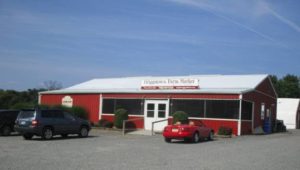
The market at Griggstown Farm in Franklin, Somerset County.
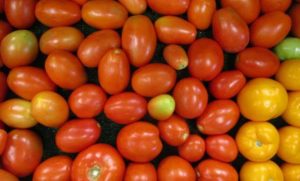
Tomatoes at Griggstown Farm.

Griggstown Farm’s cookbook library.
OCEAN TEMPERATURES: Atlantic Ocean temperatures on the New Jersey coast were in the range of about 72 to 74 degrees Thursday, August 31.

A lifeguard boat at Sea Bright, Monmouth County.
SUNRISE/SUNSET: For September 3, Sunday, to September 9, Saturday, the sun will rise about 6:30 a.m. and set about 7:20 p.m. For September 10, Sunday, to September 16, Saturday, the sun will rise about 6:35 to 6:40 a.m. and set about 7:10.
THE NIGHT SKY: The Full Corn Moon is on the Sept. 5-6, Tuesday-Wednesday, overnight.
WEATHER: The National Weather Service forecasting station for the area is at http://www.weather.gov/phi/.
UPCOMING: September 9 and 10, Saturday and Sunday, 10 a.m. to 5 p.m., the state Department of Environmental Protection’s Wild Outdoor Expo at the Colliers Mills Wildlife Management Area, Jackson, Ocean County, WildOutdoorExpo.com.

The zinnias from the garden keep on giving. Here, at a friend’s house.
Joe Sapia, 60, is a lifelong Monroe resident. He is a Pine Barrens naturalist and an organic vegetable-fruit gardener. He gardens the same backyard plot as did his Italian-American father, Joe Sr., and his Polish-immigrant, maternal grandmother, Annie Poznanski Onda. Both are inspirations for his food gardening. Joe is active with the Rutgers University Master Gardeners/Middlesex County program. He draws inspiration on the Pine Barrens around Helmetta from his mother, Sophie Onda Sapia, who lived her whole life in these Pines, and his Grandma Annie. Joe’s work also is at @JosephSapia on Twitter.com, along with Facebook.com on the Jersey Midlands page.
Article and photos by Joe Sapia
Note: The yard references are to my house in the section of Monroe between Helmetta and Jamesburg in South Middlesex County. My yard is in a Pine Barrens outlier on the Inner Coastal Plain, the soil is loamy, and my neighborhood is on the boundary of Gardening Zones 6b (cooler) and 7a (warmer). Notes and photographs are for the period covered, unless otherwise noted.
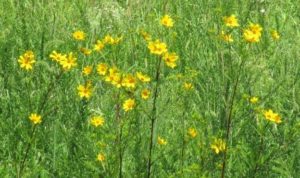
Flowers of the “Bidens” genus growing along South River Road/Route 535 in Cranbury, Middlesex County.
YELLOW FLOWERS IN FIELDS: This time of year, it is common to see a yellow flower of the “Bidens” genus on overgrown farmland. Over the last dozen years, I have seen them begin blooming from about August 20 to August 25. This year, I saw the first blooming August 24, Thursday – in this case in Cranbury, Middlesex County.
IN THE GARDEN, SWEET CORN: I wrapped up the sweet corn harvest, which produced a poor, but usable, crop. The ears developed only partially, basically one half with kernels, one half without. The poor development may be attributable to poor pollination. Corn should be planted in blocks so its pollen can fly back and forth to the plants in the wind. If pollination was the problem, I see two major reasons – one, my corn block was probably too small, in part thanks to a house re-modeling project that fouled up my garden area and by planting a bigger garden this year, I lost area to plant corn in larger blocks and, two, the wet weather may have kept down the spread of pollen. Because I like eating the corn raw off the cob or, if cooked, then sliced off with a knife, the poor development did not affect me in eating what I could harvest. But the quantity of the harvest also was terrible, meaning I had less corn to eat.
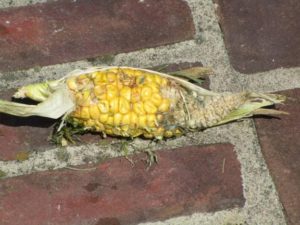
A half-developed ear of corn from the garden.
ELSEWHERE IN THE GARDEN: The early cool-weather harvest was so-so – great pickings of lettuce, carrots having a low yield, and peas bombing out. The jury is still out on the summer crop – I gave up on growing tomato plants from the seeds I planted and bought plants, only to have something eat the tops off of them; as I said, the corn generally bombed; the cucumbers bombed, probably because of too much rain, and I still have hope for mushmelon. My first-time planting of zinnias has saved the summer crop.
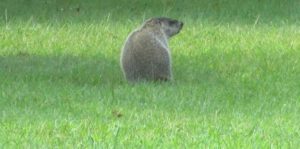
This may be the culprit that is eating the plants in my garden – a ground hog, “Marmota monax.” It was photographed in my next-door neighbor’s yard.
GRATEFUL FOR THE ZINNIAS: If it was not for my zinnias, planted in the food garden to attract pollinators, I would not have much of a summer harvest. Not only do the zinnias attract pollinators, but they are nice to look at – and give away.
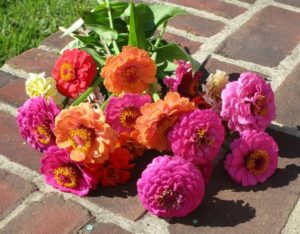
Zinnias as a gift for the eye doctor’s office.
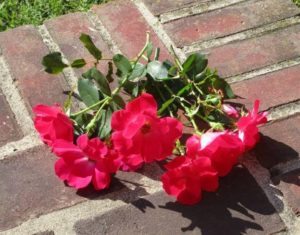
Add some Knock Out roses for the eye doctor’s office.
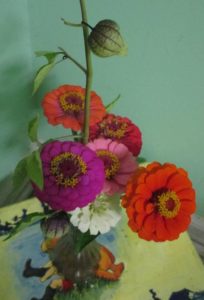
Zinnias, along with tomatillos, for the kitchen table.
ZINNIAS AND BUTTERFLIES: My morning zone-out time, just after getting up, would be watching the birds at the feeder. This summer, however, I gave up the feeder – saving money on top-quality (and costly) feed of corn kernels and putting the birds to work harvesting insects in the yard. So, until cool weather comes and the feeder goes back up, my only meditative exercise was watering the garden. Now, I found something new – watching the butterflies in the zinnia. I have discovered if I just go about my business of walking through the zinnia patch or harvesting zinnia, the butterflies just go about their business. They do not fly off by my intrusion. The butterflies and I have become friends. I am becoming one with the zinnia patch.
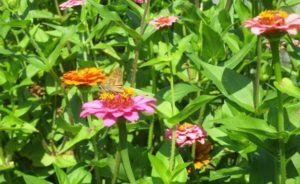
I believe the butterfly on the zinnia is a sachem, “Atalopedes campestris.”
DRAGONFLIES AROUND THE YARD: My yard seems to have hosted a lot of dragonflies this summer. Now, I have to learn to identify them.
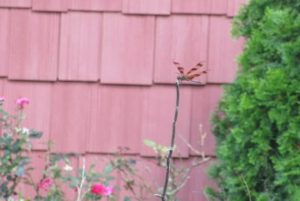
A dragonfly in my backyard.
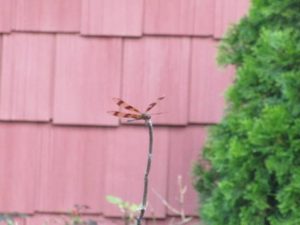
Another view of the dragonfly in my backyard.
KEYPORT HARBOR: On a free-lance writing assignment, I had to go out to the Raritan Bayshore of Monmouth County, so I stopped by Keyport harbor to crank off some photographs.
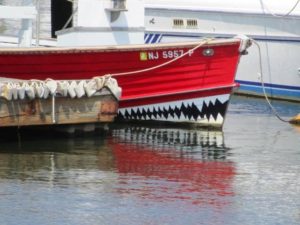 Jaws at Keyport Harbor, Monmouth County
Jaws at Keyport Harbor, Monmouth County

From Keyport harbor, looking to Staten Island, New York City, in the hazy distance.
THE ECLIPSE OF THE SUN: My plan was to stay inside during the August 21, Monday, solar eclipse, so as not to be tempted to look at the sun and possibly ruin my eyesight. Well, I was working at my desk during the eclipse, realized I left my camera in my Jeep, and went outside to retrieve it. I grabbed a kitchen strainer and, with my back to the sun, let the sunlight shine through the holes of the strainer onto my back porch. It was pretty cool, watching dozens of shadows of the sun in eclipse. With about 75 percent of the sun covered around 2:45 p.m., sun shadows were obvious, but the sunlight had the soft glow of dusk. Insects remained calling and a butterfly flew by.

The eclipse through the strainer.
BLUEBIRD SKY: While out in the yard August 24, Thursday, I noticed how clear the sky was – a “bluebird sky.” Jet airplanes could be clearly seen, with that I-almost-can-touch-them look. That means there was little moisture in the air – a dew point of only 52.
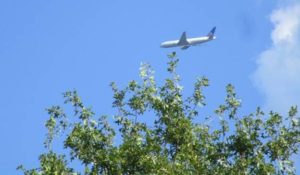
With low moisture in the air, this United Airlines flight, headed to Newark Liberty International Airport from Tel Aviv, Israel, looked very close to my backyard. It was actually flying at an estimated 3,000 feet.

Another view of the “bluebird sky” from my backyard.
DEW POINT: My go-to science guy – Joey Slezak of Helmetta, who has a bachelor’s degree in meteorology and is now working on his master’s in meteorology, both from Rutgers University – tells me dew point, not the humidity reading, is the real gauge of moisture around us and how we feel in it. Here, according to www.fredericksburg.com in Virginia, is how we feel at these dew points — under 55, pleasant; 56 to 60, comfortable; 61 to 65, getting sticky; 66 to 70, uncomfortable; 71 to 75, oppressive; more than 75, miserable.
BOBWHITE QUAIL IN NEW JERSEY: A Philadelphia Inquirer article about restoring BobWhite quail, “Colinus virginianus,” to the Pine Barrens, http://www.philly.com/philly/columnists/kevin_riordan/bringing-back-a-bird-that-once-made-a-signature-sound-of-the-pine-barrens-20170822.html. See Cornell University’s All About Birds website for more on the BobWhite, https://www.allaboutbirds.org/guide/Northern_Bobwhite/id.
CRICKETS IN MY CELLAR: As an only child, I inherited the house I grew up in and which my parents owned for almost four years before I was born in 1956. I never remember crickets in the cellar when I was a kid. But after I took over the house 15 years ago, I noticed a cricket invasion from about August until the fall weather set in. Now, a cricket-chirping cacophony is pleasant, but one or two crickets in the wee hours while one is trying to sleep is AN-NOY-ING – and it turns me from Dr. Naturalist to Mr. Killer, Serial Killer if there is more than one of these little nuisances calling away. But I just had a $38,000 re-modeling of my house, including new siding and insulation. The best $38,000 I could spend on eradicating crickets from the cellar. So far, and it is already late August, only six crickets – none of which are with us anymore. I mean, if a cricket wants to live outside and chirp away, I get it. But if a cricket wants to invade my cellar and rub those little ugly legs together, NO. (OK, OK, OK, now that I feel sort of bad about cricket killing, I will tell you about Revenge of the Crickets. A few years ago, I saw a cricket in the cellar. And I had had it! So, I picked up the pail I used to empty de-humidifier water into and SMASHED the cricket. I poured the de-humidifier water into the bucket — and the water spilled onto the cellar floor. Yes, I had cracked the bucket when I obliterated the cricket. I never learn – whenever I act surly, I pay for it.)
(Sorry, no photo of a dead cricket.)
OCEAN TEMPERATURES: Atlantic Ocean temperatures on the New Jersey coast were in the range of about 74 to 77 degrees.
SUNRISE/SUNSET: For August 27, Sunday, to September 2, Saturday, the sun will rise about 6:20 to 6:25 a.m. and set about 7:30 p.m.
WEATHER: The National Weather Service forecasting station for the area is at http://www.weather.gov/phi/.
UPCOMING: September 9 and 10, Saturday and Sunday, 10 a.m. to 5 p.m., the state Department of Environmental Protection’s Wild Outdoor Expo at the Colliers Mills Wildlife Management Area, Jackson, Ocean County, WildOutdoorExpo.com.
DOES ANYBODY ELSE…?: …Go to a fast-food restaurant and instead of tossing in the garbage all the paper packaging and so on, take it home for recycling?

Sailboats at Keyport harbor.
Joe Sapia, 60, is a lifelong Monroe resident. He is a Pine Barrens naturalist and an organic vegetable-fruit gardener. He gardens the same backyard plot as did his Italian-American father, Joe Sr., and his Polish-immigrant, maternal grandmother, Annie Poznanski Onda. Both are inspirations for his food gardening. Joe is active with the Rutgers University Master Gardeners/Middlesex County program. He draws inspiration on the Pine Barrens around Helmetta from his mother, Sophie Onda Sapia, who lived her whole life in these Pines, and his Grandma Annie. Joe’s work also is at @JosephSapia on Twitter.com, along with Facebook.com on the Jersey Midlands page. Copyright 2017 by Joseph Sapia
Article and photos by Joe Sapia
Note: The yard references are to my house in the section of Monroe between Helmetta and Jamesburg in South Middlesex County. My yard is in a Pine Barrens outlier on the Inner Coastal Plain, the soil is loamy, and my neighborhood is on the boundary of Gardening Zones 6b (cooler) and 7a (warmer). Notes and photographs are for the period covered, unless otherwise noted.
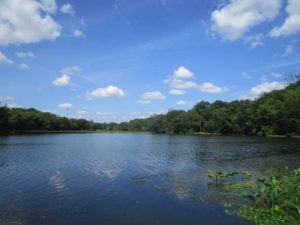
Etra Lake, in East Windsor, Mercer County, sits on the Inner Coastal Plain. Most, if not all, bodies of water on New Jersey’s Inner and Outer Coastal Plains, are human-made – in Etra Lake’s case by the damming of Rocky Brook. Rocky Brook is part of the Raritan River-Bay watershed. The damming of the lake appears to go back to the late 1700s to create a power source to run a grist mill. The name “Etra” actually is an acronym, “ETRA,” after a prominent resident, Edward Taylor Rosel Applegate, born in 1831 and died in 1915.
THE CUESTA: Of New Jersey’s four land regions, two are in the Jersey Midlands – the rolling terrain of the Piedmont and the generally flat Coastal Plain. The Coastal Plain can be broken down further – the Outer and Inner. What people may not realize is the Coastal Plains are divided by an on-again, off-again hill system – the cuesta. The cuesta essentially runs from Sandy Hook in the northeast to the Philadelphia area in the southwest. It can easily be traced on a map through place names, from northeast to southwest – Highlands, Atlantic Highlands, Crawford Hill (391 feet above sea level) and Telegraph Hill (360 feet) in Holmdel, Quail Hill (258 feet) in Manalapan, Backbone Hill Road (250 feet) in Millstone, all in Monmouth County; Arneys Mount (230 feet) in Springfield, Mount Holly (183 feet), and Mount Laurel (173 feet), all in Burlington County. The cuesta or cuestas may rise hundreds of feet around surrounding land; Crawford Hill, for example, is the highest point in Monmouth County and rises about 350 feet over surrounding lowlands. The cuesta formation was formed at the time of the late Cretaceous and early Tertiary ages, two periods of geologic time that met about 66-1/2 million years ago. It basically was formed by water runoff, eroding the surrounding land and leaving the cuesta. The cuesta remains because it is cemented together by ironstone.
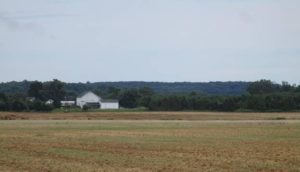
2017, August 6, Sunday — A view of the cuesta from the Union Transportation Trail in Upper Freehold, Monmouth County. The view is looking toward the Shore, so the abrupt rise in the terrain is seen. From the other side of the cuesta, the change in terrain is more gradual.
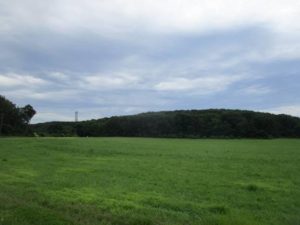 2017, August 6, Sunday — Another view of the cuesta – here, near the Horse Park of New Jersey in Upper Freehold, Monmouth County.
2017, August 6, Sunday — Another view of the cuesta – here, near the Horse Park of New Jersey in Upper Freehold, Monmouth County.

2016, January – Looking at the cuesta, about 200 feet above sea level, across Sandy Hook Bay from Sandy Hook.
BUTTERFLIES IN THE ZINNIA PATCH: Last year, my newspaper reporting travels took me to Bobby Laurino’s farm market in Colts Neck and Andy Capelli’s farm market in Middletown. I was amazed by the bees and butterflies attracted to their zinnia patches. Here was this abundance of pollinators and they were fun to watch. So, I did some research on zinnia – liking it because it is an annual, not a perennial I would be stuck with – and planted it in my garden, about 35 to 40 row feet. I wish I planted more! In recent days, I have spotted these butterflies: painted lady, “Vanessa cardui”; spicebush swallowtail, “Papilio troilus”; cabbage white, “Pieris rapae”; silver-spotted skipper, “Epargyreus clarus”; and monarch, “Danaus plexippus.” I try to become one with the zinnia patch, or at least letting the butterflies do their thing and me doing my thing, which allows me to get close to them and take great photographs.
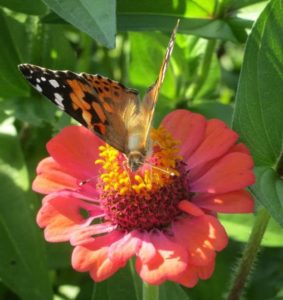
A painted lady butterfly in my zinnias.
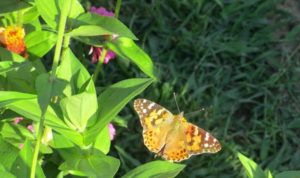
Painted lady in the zinnias.

Painted lady on a zinnia.
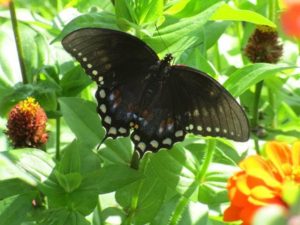
Spicebush swallowtail in the zinnias.
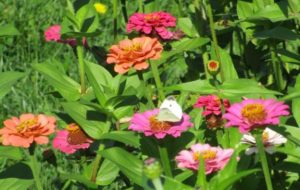 Cabbage white in the zinnias.
Cabbage white in the zinnias.
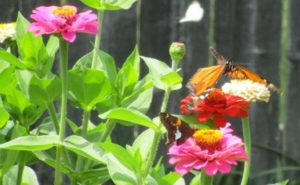
Silver-spotted skipper, lower, and monarch, upper, in the zinnias.
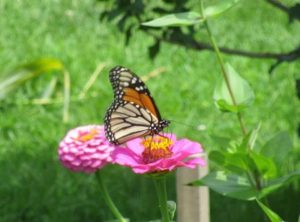
Monarch in the zinnias.
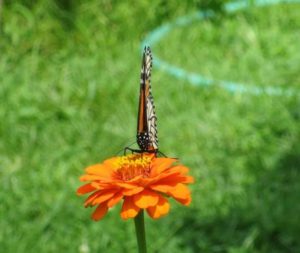
Monarch on a zinnia.
SOURCES, BUTTERFLIES: I love this Internet site of the North American Butterfly Association (NABA)-North Jersey Butterfly Club for identifying butterflies, http://www.naba.org/chapters/nabanj/butterflies.html.
GARDEN VOICE NO. 1, DEBBIE MANS: Debbie Mans reported, “We were just comparing notes at work on our gardens and we are all not seeing great results — split tomatoes, fizzled squash, slow on the tomatoes ripening, etc. This is in Monmouth County and Essex County. I am hearing more and more from others, too. You are not alone!” (Debbie is executive director and baykeeper for the New York-New Jersey Baykeeper environmental group based in Keyport, Monmouth County. Here is a profile I wrote of Debbie last year, http://tworivertimes.com/debbie-mans-midwesterner-with-jersey-sand-in-her-shoes/.)
NAVESINK RIVER BOAT RIDE: Debbie Mans’s New York-New Jersey Baykeeper group is sponsoring a Navesink River boat ride September 19, Tuesday, out of Atlantic Highlands, Monmouth County. Last year, I sailed with the Baykeeper on a Sunday afternoon on Raritan Bay and the Shrewsbury River – a great time! So, if free, consider the Navesink River ride. Monmouth County’s Navesink River, one of my favorite places in the Jersey Midlands as it flows along the cuesta emptying into the Shrewsbury River. For the Navesink River Sunset Eco Cruise.

2015, December – Along the Navesink River.
GARDEN VOICE NO. 2, JACK MAHON: South Jersey gardener Jack Mahon and I recycle dehumidifier water, using it for gardening watering. But, this year, both Jack and I have noticed something – the heavy rains have left us with an overabundance of water. “The rain has been so heavy at times that the dehumidifier is way ahead of the trees’s need for water,” Jack said. Ditto. In recent days, my two barrels of water for the garden, totaling 50 gallons, have been full.
IN THE GARDEN AND YARD: I continued harvesting flowers, both zinnias and Knock Out roses, along with sweet corn. The fall crop is sprouting. And I watch the cucumbers and cantaloupe, hoping something comes about. The cantaloupes look OK as they grow, but the cucumbers seem to be victims of too much rain and I wonder if I will even get one to use.
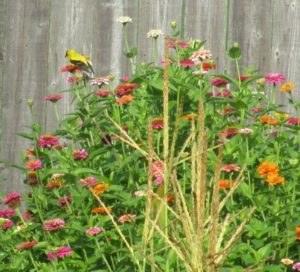
A male Eastern goldfinch, “Spinus tristis,” perched on a zinnia flower in the garden.
MONROE TOWNSHIP COMMUNITY GARDEN: I visited my lifelong hometown’s Community Garden and Park. It is a nice setting along the Millstone River. But I wish Monroe, which continues to develop heavily, would practice greener principles. For example, abandon magazine-photograph lawns and replace them with more productive organic gardens. Me, I am trying to go with as little lawn as possible – and my lawn is chemical-free. I know, I strive for an Old Monroe in a New Monroe whose population over its approximately 42 square miles is an estimated 45,000, a big difference from the estimated 5,000 when I was born in 1956.
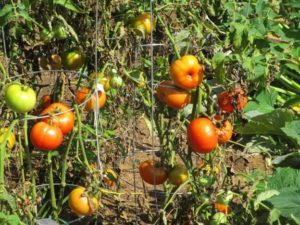
Tomatoes in the Monroe Community Garden and Park.
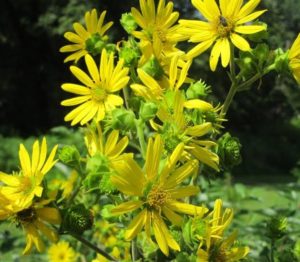
Flowers at the Monroe Community Garden and Park.
THE ECLIPSE OF THE SUN: On Monday, August 21, New Jersey will be treated to a partial solar eclipse. It begins at 1:22 p.m., peaks at 2:44 p.m., and ends at 4 p.m. DO NOT LOOK AT THE ECLIPSE UNLESS YOU HAVE SPECIAL PROTECTIVE EYEWEAR. (While I find the eclipse exciting, I do not want to take chances of looking up. So, I will take a nap, work in my cellar or garage, or follow the eclipse on the computer or television.) See https://eclipse2017.nasa.gov/.
CARDINAL PHOTO: The photo of a cardinal, “Cardinalis cardinalis,” in last week’s “Garden and Afield” drew a nice response from backyard neighbor Fran D’Aiello Rosuck. Fran and her husband, Ed, have been my family’s neighbor for about 40 years, or since about the time I went on my own after college. Then, after my parents, Joe Sapia Sr. and Sophie Onda Sapia, died, I, as an only child, moved back and took over the house. This summer, the outside of the house was remodeled. Fran said, “I always read that a cardinal is a visitor from Heaven. Your mom is probably saying the house never looked so good.” What a nice comment to find on my “The Jersey Midlands” page on Facebook.com.
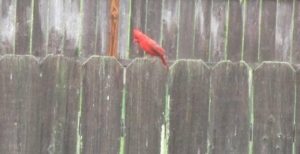
The cardinal at my garden. Actually, it is on backyard neighbor Fran D’Aiello Rosuck’s fence.
OCEAN TEMPERATURES: Atlantic Ocean temperatures on the New Jersey coast were in the range of about 75 to 77 degrees.
SUNRISE/SUNSET: For August 20, Sunday, to August 26, Saturday, the sun will rise about 6:15 to 6:20 a.m. and set about 7:40 to 7:50 p.m. For August 27, Sunday, to September 2, Saturday, the sun will rise about 6:20 to 6:25 a.m. and set about 7:30 p.m.
WEATHER: The National Weather Service forecasting station for the area is at http://www.weather.gov/phi/.
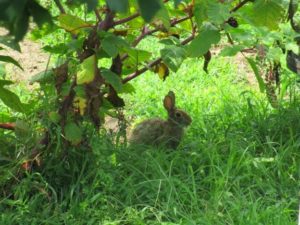 Rabbit, genus “Sylvilagus,” in the garden.
Rabbit, genus “Sylvilagus,” in the garden.
Joe Sapia, 60, is a lifelong Monroe resident. He is a Pine Barrens naturalist and an organic vegetable-fruit gardener. He gardens the same backyard plot as did his Italian-American father, Joe Sr., and his Polish-immigrant, maternal grandmother, Annie Poznanski Onda. Both are inspirations for his food gardening. Joe is active with the Rutgers University Master Gardeners/Middlesex County program. He draws inspiration on the Pine Barrens around Helmetta from his mother, Sophie Onda Sapia, who lived her whole life in these Pines, and his Grandma Annie. Joe’s work also is at @JosephSapia on Twitter.com, along with Facebook.com on the Jersey Midlands page.
Article and photos by Joe Sapia
Note: The yard references are to my house in the section of Monroe between Helmetta and Jamesburg in South Middlesex County. My yard is in a Pine Barrens outlier on the Inner Coastal Plain, the soil is loamy, and my neighborhood is on the boundary of Gardening Zones 6b (cooler) and 7a (warmer). Afield references are to the Pine Barrens around Helmetta, unless otherwise noted. Notes and photographs are for the period covered, unless otherwise noted.
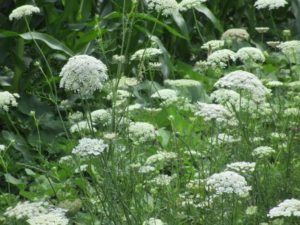
Queen Anne’s lace along a roadside in Monroe, Middlesex County.
THE DRIVE-BY NATURALIST: During the week, I noticed the white-flowered Queen Anne’s lace, “Daucus carota,” blooming along various roadsides. Also, blue-flowered chicory, “Cichorium intybus,” remains in bloom. This got me thinking, how we can observe nature as we drive by. As I try to point out, keep your eyes open – for plantlife and wildlife, along with looking up at the daytime and night skies. Nature is around us, so do not miss out on it. And keep the camera ready!
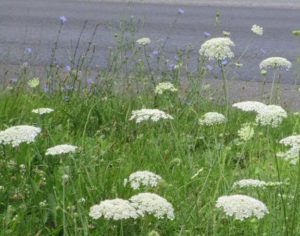
Here, Queen Anne’s lace, the white flower, and chicory, the blue flower, in bloom along a roadside.
ON MY DRIVE-BYS: Despite the warm temperatures during the week, I have been watching for the changing colors of foliage. Yes, it is only July, but the “fall” foliage changing of colors should be starting right about now in the wetlands in the Pine Barrens around Helmetta. I have not seen it yet, but I generally look for changing colors in swamps beginning somewhere in the July 15-to-July 31 period.
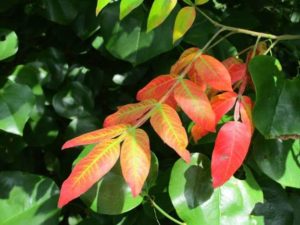
Here, leaves changing colors in 2015, late July, at Cranberry Bog in the Pine Barrens around Helmetta.
SPOTTED ON A DRIVE-BY: As I was putting together this week’s “Garden and Afield,” I shot some last-minute photographs and was driving home when I noticed some deer, “Odocoileus virginianus,” just off the road near Manalapan Brook on the Monroe-Spotswood boundary, Middlesex County. Usually when you see a fawn, Mama is nearby. On this day, though, I caught what I consider an uncommon sight, fawns and a buck (whose antlers were in velvet). Mama Deer was probably keeping an eye on the fawns from nearby in the woods.
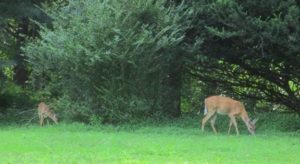
A fawn and a buck in Monroe, Middlesex County.
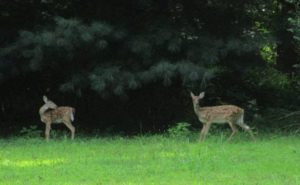
Two fawns in Monroe, Middlesex County.
LOW-MOISTURE-IN-THE-AIR BLUE SKY: Ever notice days when the sky just has that clear look to it? Based on my Roman Catholic upbringing and 16 years in Catholic schools, I call it a “Blessed Mother Blue Sky,” because the sky has the look of the blue clothing associated with the Virgin Mary. Joey Slezak, my go-to science guy in the Pine Barrens around Helmetta, calls it a “Bluebird Sky.” “The first I heard ‘Bluebird Skies’ is (when I was) skiing,” Joey said. “People talking about it. You have white (snowy) ground contrasting the blue sky.” Joey, who has a bachelor’s degree in meteorology from Rutgers University and has completed his master’s degree course work in meteorology at the university, explained the clearness translates as “low moisture” in the air.
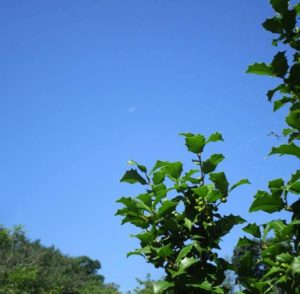
The clear blue sky is a result of low moisture in the air as the moon wanes after the July 8-9 overnight Full Thunder Moon. The next full moon is the August 7-8 overnight Full Red Moon
GARDEN ENEMIES: I have not seen the ground hog and its offspring lately, although the wood steps at one of my house doors is collapsing into their burrow. The rabbits are always around. Then, the other day, I found deer droppings and hoof prints in my garden. Finally, I found the tops of my tomato plants snipped off. Well, there goes this year’s tomato crop….
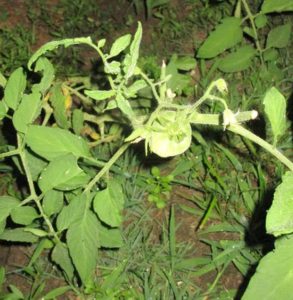
A snipped-off tomato plant in the garden.
WATERING THE GARDEN OBSESSION, NO. 1: On Sunday, July 16, for the first time since planting the food garden around May 20, I was able to water it completely by hand, using water I had accumulated in garbage can reservoirs. I used roughly 30 gallons for the 950-square-foot, or 315-row-feet garden. Now, to replenish the 20-gallon and 30-gallen barrels with rainwater, cellar de-humidifier water, water caputured while sprinkling the garden using the house system, and water from Manalapan Brook. (I keep the barrels covered so as not to promote mosquito development.)
WATERING THE GARDEN OBSESSION, NO. 2: With the water accumulated in my barrels, I thought I could cheat a little, by hooking up a simmer pump and hose to a sprinkler, rather than walking the garden with sprinkling cans. Well, I clogged the sprinkler, which required me unclogging it – but not until I gave up on using the pump for sprinkling. I guess the pump picked up gunk from the water barrel. And I am not even sure the pump was powerful enough to propel the sprinkler properly.
WATERING THE GARDEN, OBSESSION NO. 3 — MANALAPAN BROOK: I grabbed two buckets and took the walk of a few hundred feet to Manalapan Brook, the section between “Jamesburg Lake” (Lake Manalapan) and “Spotswood Lake” (DeVoe Lake). There, I was greeted by my friends, ebony jewelwing damselflies, “Calopteryx maculate.” I waded into the Brook, filled the two buckets, took some photographs, and headed home.
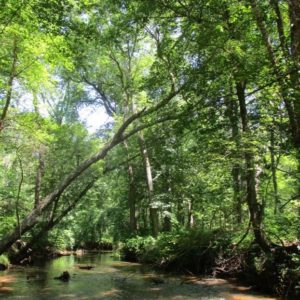
Manalapan Brook in the section of Monroe between Helmetta and Jamesburg, looking downstream toward Helmetta.
ELSEWHERE IN THE GARDEN: I am awaiting cantaloupe/mushmelon and sweet corn, both seemingly behind on the calendar from last year. The tomatillos, which I did not plant, are ready for harvesting; I will pass them along to a co-worker. Otherwise, I had some pea seeds laying around I decided to plant about a week or so ago; They are sprouting.
THE SIZE OF MY GARDEN: Friend, fellow hiker, and fellow gardener Priscilla “Peppy” Bath had an interesting observation about my garden: “Your vegetable garden is so good as you tell about it. I expected it to be much bigger. …Perhaps it would be interesting to others that you do not have one to two acres, but just a normal back yard.” Yes, my yard is only about a quarter-acre. “It would possibly encourage others to make a vegetable garden in their backyards,” Peppy said. I think people do not realize how productive a small garden could be. So, I reached out to friend Diane Larson, who is the home horticulturist and Master Gardener coordinator for the Rutgers University Extension Service office in Freehold, Monmouth County. The Monmouth County Master Gardeners garden is about 40 feet by 50 feet, or about 2,000 square feet. From 2006 to 2016, or over 11 growing seasons, the garden has produced 26,000 pounds of vegetables – an average of about 2,364 pounds per year, all donated to food pantries serving the needy. “The best part, besides all the produce going to food pantries, is that the MGs learn so much out there,” Diane said. “Some have never grown vegetables and they love it.”
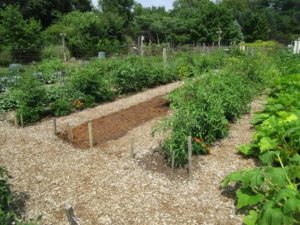
The Monmouth County Master Gardeners garden in Freehold Township. This 40-foot by 50-foot garden has averaged a yield of 2,364 pounds per year from 2006 to 2016, with all the food donated to the needy.

Another view of the Monmouth County Master Gardeners garden.
ZINNIA OBSESSION: My new obsessive-compulsive fascination – the zinnias I planted to attract pollinators to the food garden. For next year, I plan to dig up the front lawn and plant zinnias there, too.

Zinnias in the garden.
FIRE IN THE MAIN PINE BARRENS: A wildfire has burned about 3,500 acres in Wharton State Forest. The fire remained burning as of Saturday, July 22. The good news is the fire — whose cause is, so far, undetermined — is not near buildings, which means the fire, too, will help keep the Pine Barrens a pine barrens. The Pine Barrens is an early succession ecosystem, so the fire – by knocking down the oaks that would shade out the pines – keeps succession in check. The pines may look like burned spars, but they are alive and can regenerate from their trunks, along with root growth and new growth of wildfire-spread seeds; The oaks, on the other hand, cannot regenerate from the trunks, but have to start all over, so to speak, by root growth. On Saturday, the fire was considered “contained,” meaning firefighters had a safe perimeter around it.
ELSEWHERE IN THE YARD: I am slowly reclaiming my yard after 4-1/2 weeks of a major remodeling project on my house – new roof, soffits, gutters and drainpipes, and siding. (For the first time since the house was built in 1952, it is no longer mint green. The retro green has been replaced by barn red.) So, I have been cutting the lawn and trimming shrubs, along with figuring how to approach my neglected garden. And I finally put up the screen tent that has been sitting in a box in my garage for a few weeks. Now, without getting bit by mosquitoes, I can spend warm nights in the screen tent reading, writing, listening to the radio, or just enjoying being outside. Next year, I plan to put the screen tent in a better location, farther from the house, closer to the garden. So, I put up the screen tent and almost immediately it began raining, then monsooning. …Oh, yes, the contractors still have a few odds and ends to finish, but I do have the yard back under my control.
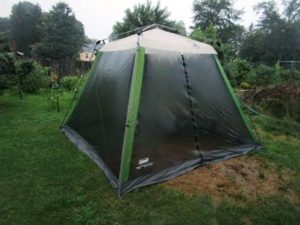
The brand-new, and rain-drenched, screen tent in my backyard.
SOURCES, BOOK NO. 1: One of my book sources is “Dictionary of Plant Names” by Allen J. Coombes, 1985 to 1989, Timber Press. I have had this book for an estimated 25 or more years and have repeatedly turned to it. It lists plants by common and scientific names, cross-referencing the two – for example, mountain laurel, “Kalmia latifolia.” It goes on, saying the genus name is from naturalist Pehr Kalm (who did work in the 1700s in the South Jersey area) and the species name translates from Latin as “broad-leaved.” Mountain laurel, according to the book, is also known as “calico bush.” I use this book both on its own and in conjunction with plant-illustration books.

“Dictionary of Plant Names” by Allen J. Coombes
TURKEY FOLLOWUP: Bob Eriksen, a retired turkey biologist of the state Department of Environmental Protection, made some observations after seeing the photograph of the wild turkeys, “Meleagris gallopavo,” in the Pine Barrens around Helmetta published in the July 9 “Garden and Afield.” Bob said, “Good to see a hen turkey with at least three poults. They are all old enough that they likely will survive to adulthood.”
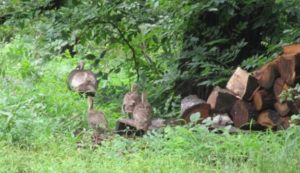
A turkey hen and her three poults in the Pine Barrens around Helmetta, specifically in the Jamesburg Park section of East Brunswick, Middlesex County.
ATLANTIC OCEAN TEMPERATURES: The ocean temperatures have run from about 70 degrees to the lower 80s. On July 18, Tuesday, Glenn “Hurricane” Schwartz, a Philadelphia television Channel 10 meteorologist, said online, “The Atlantic City ocean temperature is now up to 80 degrees. That’s practically unheard of for July. (It) peaks in August. 10 degrees above average.”
UPCOMING COUNTY FAIRS: Monmouth County Fair is July 26, Wednesday, to July 30, Sunday, in Freehold Township, https://www.monmouthcountyparks.com/page.aspx?ID=2492. Mercer County 4-H Fair, July 29, Saturday, and July 30, Sunday, in Hopewell Township, http://mercer.njaes.rutgers.edu/4h/fair/. Middlesex County Fair, August 7, Monday, to August 13, Sunday, in East Brunswick, http://middlesexcountyfair.com/. Somerset County 4-H Fair, August 9, Wednesday, to August 11, Friday, in Bridgewater, http://www.somersetcounty4h.org/fair/. Hunterdon County 4-H and Agricultural Fair, August 23, Wednesday, to August 27, Sunday.
SUNRISE/SUNSET: For July 23, Sunday, to July 29, Saturday, the sun will rise at about 5:50 a.m. and set about 8:18 p.m.
WEATHER: The National Weather Service forecasting station for the area is at http://www.weather.gov/phi/.
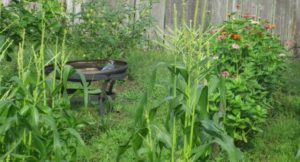
A blue jay rests in the garden, surrounded by sweet corn, tomatillos, and zinnia.
Joe Sapia, 60, is a lifelong Monroe resident. He is a Pine Barrens naturalist and an organic vegetable-fruit gardener.
He gardens the same backyard plot as did his Italian-American father, Joe Sr., and his Polish-immigrant, maternal grandmother, Annie Poznanski Onda. Both are inspirations for his food gardening. Joe is active with the Rutgers University Master Gardeners/Middlesex County program. He draws inspiration on the Pine Barrens around Helmetta from his mother, Sophie Onda Sapia, who lived her whole life in these Pines, and his Grandma Annie. Joe’s work also is at @JosephSapia on Twitter.com, along with Facebook.com on the Jersey Midlands page.
Article and photos by Joe Sapia
Note: The yard references are to my house in the section of Monroe between Helmetta and Jamesburg in South Middlesex County. My yard is in a Pine Barrens outlier on the Inner Coastal Plain, the soil is loamy, and my neighborhood is on the boundary of Gardening Zones 6b (cooler) and 7a (warmer). Afield references are to the Pine Barrens around Helmetta, unless otherwise noted. Notes and photographs are for the period covered, unless otherwise noted.
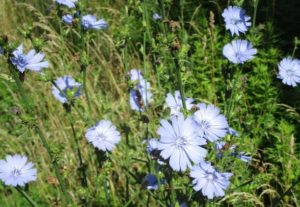
Blooming along a roadside in East Windsor, Mercer County, the beautiful, but non-native, chicory, “Cichorium intybus.”
IN THE FOOD GARDEN: I picked a cherry tomato and some carrots. Otherwise, the garden is between harvesting the early season crop of lettuce and awaiting the warmer weather crop of sweet corn, cantaloupe/mushmelon, and more tomatoes. So, come on pollination – the sweet corn has begun forming tassels (the male flower) and some silk (the female flower), while the mushmelon continues to flower in yellow.
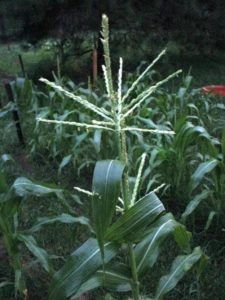
Tassels, or the male flower, on the sweet corn in the garden.
ZINNIA IN THE FOOD GARDEN: Hopefully attracting pollinators to the food garden this year are the score of blooming zinnia of orange, yellow, purple, pink, white, and rose. I have been watching more and more flowers develop this week and, in turn, various pollinators – butterflies, bees, and flies – visiting the zinnia. This is my first year using zinnia, getting the idea from watching pollinators visiting the zinnia at Bobby Laurino’s R.J. Laurino Farms in Colts Neck (www.rjlaurinofarms.com) and Andy Capelli’s Capelli Farms in Middletown (www.capellifarms.com). For next year, I plan to go zinnia-crazy, interspersing rows throughout the food garden and converting more lawn to zinnia growing.
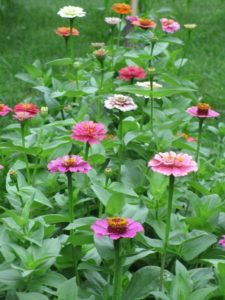
Zinnia in bloom in the garden.
FRUITING IN THE WILDS: Heads up in the wilds, blackberries, genus “Rubus,” should be fruiting here and there. Yes, they are edible – and taste great! From the New Jersey Department of Agriculture, http://www.nj.gov/agriculture/farmtoschool/documents/seasonality-chart/F2S%20Blackberries.pdf.
NEW BRUNSWICK IN FLOWER: I work part-time at Rutgers University’s Jules and Jane Plangere Writing Center at the College Avenue Campus in New Brunswick. But my parking area is cross-town, about 2 miles away at the Douglass College campus. This time of year, especially, I try to walk both ways. The walk gives me a great opportunity to photograph the city of my birth – St. Peter Hospital, Class of 1956. This week, I photographed flowers – white, light pink, dark pink, yellow, red. (Side note: For about half of my 31-year newspaper reporting career at the Asbury Park Press, Mr. Plangere was an owner. Mr. Plangere died in September at 95 years old – but he is still taking care of me!)

Flowering New Brunswick.
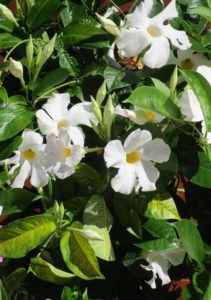
More of flowering New Brunswick.
STARLINGS: Blame these European invaders on lovers of playwright William Shakespeare! According to Cornell University’s All About Birds website, “All the European Starlings (“Sturnus vulgaris”) in North America descended from 100 birds set loose in New York’s Central Park in the early 1890s. The birds were intentionally released by a group who wanted America to have all the birds that Shakespeare ever mentioned. It took several tries, but eventually the population took off. Today, more than 200 million European Starlings range from Alaska to Mexico, and many people consider them pests.”
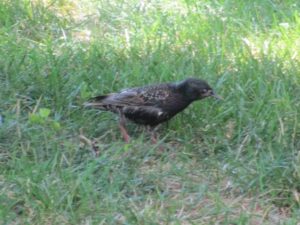
A starling on a New Brunswick lawn.
GARDEN TOOLS: As an only child, I inherited the house I grew up in, moving back to it in 2002. My parents, Joe Sapia Sr. and Sophie Onda Sapia, are the original owners of the house, dating to 1953 and my maternal grandmother, Annie Poznanski Onda, moved in with us in probably 1966. So, basically, three generations have lived here, meaning three generations of “stuff” reside here. When I moved back, I rented a 30-cubic-yard trash bin and cleaned house, except for things that were sentimental and things I figured I could use. So, today, if I need something, before I go out and buy it, I check if I have it around the house or check to see if I can rig something together from what I have around the house. This includes gardening tools. I have a shovel I use frequently and a garden claw for weeding, both with loose handles. A few days ago, I got tired of this loose-handle stuff. So, I used a technique Uncle John Onda taught me when I was a kid: place the item in water, the wood will swell, end of the loose object. I taped the claw and the shovel to the way I wanted the handles positioned, then I put them in my 20-gallon garbage can of gardening water I keep handy. About 36 hours later, I pulled them out – gardening tools that no longer have loose handles. This week, I took another shovel and am doing the same thing.
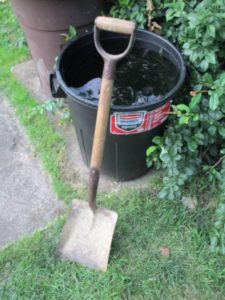
This shovel is about to be soaked in the barrel of garden water.
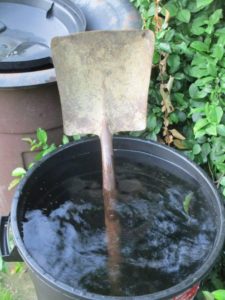
The shovel handle soaking, and swelling, in the barrel of gardening water.
OCEAN TEMPS: Atlantic Ocean water temperatures at the Jersey Shore are running at about 73 degrees to 76 degrees. The average at Sandy Hook for July 16 to 31 should be 71 degrees, according to the National Oceanic and Atmospheric Administration (NOAA).
RIP CURRENTS: This season, you may have seen various warnings of rip currents during television or radio weather reports. Rip currents – also referred to incorrectly as “rip tides” – are currents of water being returned to the ocean from the beach. A rip current dissipates within hundreds of feet, but that is enough time to sweep a swimmer out into the ocean or make it difficult for that swimmer to swim back to the beach against a rip. Basically, there are three things a swimmer can do. One, rips are relatively narrow, so the swimmer can try getting out of the rip by swimming parallel to Shore, rather than back in, until he or she is out of the rip. Two, ride out the rip and, then, swim parallel to Shore and back in. Three, float and signal for help. See NOAA’s advice, http://www.ripcurrents.noaa.gov/surviving.shtml.
WHITE ORCHID IN THE PINES: As its name suggests, the pink lady slipper orchid, “Cypripedium acaule,” generally has a pink flower. But rarely, the flower can be white. During this year’s pink lady slipper blooming season, basically late April-early May into June, outdoorsman Jay Schoss, who is a trustee of the Outdoor Club of South Jersey, found a rare white one in the Whitesbog, Burlington County, area of the Pine Barrens. I have never seen one that I can recall in my 60 years! A great find. (Thanks to outdoorswoman Faye Bray, an Outdoor Club member, for taking the photo and coming through in supplying it. The white variety was “freaking remarkable” and “absolutely beautiful,” Faye said. If you get a chance, take an OCSJ hike led by Jay or Faye. Both are great leaders and great people.)
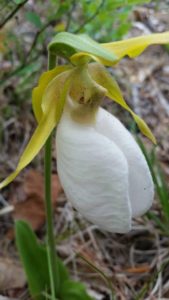
rare white flower of a pink lady-slipper orchid.
LAST WEEK’S DRAGON FLY: Roger Dreyling, a lifelong Jamesburg area outdoorsman and my cousin through marriage, identified the dragonfly I could not identify last week. It is a common whitetail, “Plathemis lydia.”
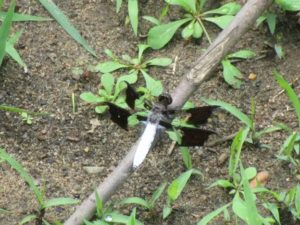
A common whitetail dragonfly in the garden earlier in July.
SUNRISE/SUNSET: For July 16, Sunday, to July 22, Saturday, the sun will rise at about 5:45 and set about 8:25 p.m.
WEATHER: The National Weather Service forecasting station for the area is at http://www.weather.gov/phi/.
NORTHERN LIGHTS: Mass ejections from an explosion at the Sun are to reach Earth Sunday, July 16, possibly enhancing viewing of the Aurora Borealis, or “Northern Lights.” The National Weather Service is saying the Northern Lights may be visible as far south as the Great Lake States and New England. Hmmmm, close enough to us to take a look into the Night Sky on the Sunday-Monday overnight.
I HAVE GOT MY YARD BACK: After almost five weeks of a house-remodeling project (altering the roofline, new roof, new siding, new gutters and drainpipes, and little things here and there), I have reclaimed my yard from the contractors – not totally, because a few odds and ends remain in the coming week or two, but generally. This means, I can get back to some very-needed yardwork – cutting the lawn, trimming the shrubs, and maintaining the garden.
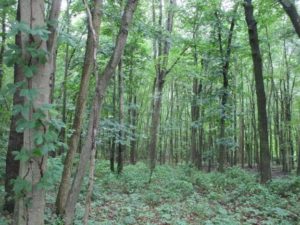
The hardwood forest at Van Dyke Farm, a combination of farm and woods in South Brunswick, Middlesex County.
Joe Sapia, 60, is a lifelong Monroe resident. He is a Pine Barrens naturalist and an organic vegetable-fruit gardener.
He gardens the same backyard plot as did his Italian-American father, Joe Sr., and his Polish-immigrant, maternal grandmother, Annie Poznanski Onda. Both are inspirations for his food gardening. Joe is active with the Rutgers University Master Gardeners/Middlesex County program. He draws inspiration on the Pine Barrens around Helmetta from his mother, Sophie Onda Sapia, who lived her whole life in these Pines, and his Grandma Annie. Joe’s work also is at @JosephSapia on Twitter.com, along with Facebook.com on the Jersey Midlands page.
Article and photos by Joe Sapia
Note: The yard references are to my house in the section of Monroe between Helmetta and Jamesburg in South Middlesex County. My yard is in a Pine Barrens outlier on the Inner Coastal Plain, the soil is loamy, and my neighborhood is on the boundary of Gardening Zones 6b (cooler) and 7a (warmer). Afield references are to the Pine Barrens around Helmetta, unless otherwise noted. Notes and photographs are for the period covered, unless otherwise noted.
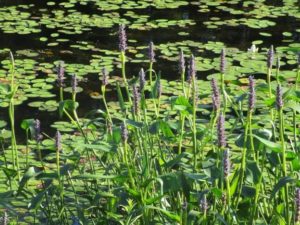
Pickerel weed flowering in Helmetta Pond.
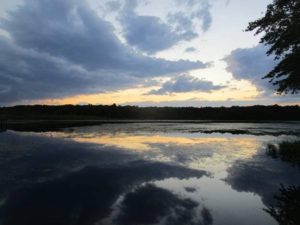
Sunset at Helmetta Pond.
TURTLES: I am still hearing a lot of talk about people coming across turtles, including misidentifying box turtles, “Terrapene carolina Carolina,” as water turtles. While a box turtle will go into water, it is generally a land turtle. So, if it is necessary to move a turtle for its safety, simply move it in the direction it is traveling. In recent days, Garden and Afield reader Bill McGovern came across two box turtles in his yard in Brick, Ocean County, and he reported, “Of course, I didn’t disturb the moment!” But he did supply a photograph of the mating turtles.
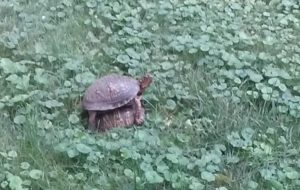
Mating box turtles in Bill McGovern’s front yard in Brick, Ocean County. An easy way to identify the gender of box turtles is by their plastrons, or underside. A female’s is flat. A male’s is concave, so he can ride the female in mating, as shown in the photo.
BLUEBERRIES: Sophie Majka, a long-time neighbor of my family in the Pine Barrens around Helmetta, told me a little bit of local lore: Blueberries are ready to pick on St. John’s Day.
Saturday, June 24, was St. John the Baptist Day. So, a few days later, I did a quick check of the woods and found a few berries — actually, probably black huckleberry, “Gaylussacia baccata.” A few ripened blue, most still green. Based on reports I have been seeing from the main Pine Barrens to the south, they have been ripe there for several days. The berries will be around for the upcoming weeks.
Black huckleberry — along with low-shrub blueberries of the genus “Vaccinium” — are found on the uplands as the shrub understory of the forest. In the fall, these low-shrub berry plants are easy to identify because they turn flame red with the changing of “fall foliage” colors.
For those more daring, head to the swamps for taller blueberry bushes of the genus “Vaccinium.”
Just a note: Wild blueberries are not commercially cultivated berries, so they are smaller.
A few years ago, Mrs. Majka and I spent some time up Jamesburg Park, picking the low-shrub blueberries. Mrs. Majka died at 92-years-old in March. This week, in the area where she and I picked, berries were ripening, providing a nice memory of Mrs. Majka.
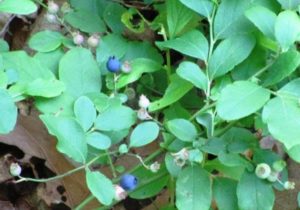
“Blueberries,” probably black huckleberries, at Jamesburg Park.
IN THE GARDEN: I am harvesting carrots, but not to the extent I thought I would. Lettuce has taken on a bitter taste, so I stopped harvesting that. Cantaloupe and zinnia plants are flowering. Also watching tomato, cucumber, and sweet corn grow. Aside from harvesting carrots, I am back to the three Ws: Weed, Water, and Wait.
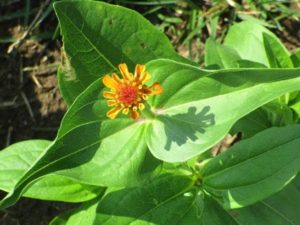
Zinnia, with which I hope to attract pollinators for the food plants, beginning to bloom in the garden.
GARDENING KNOW-HOW: I use various sources to learn about my food gardening: my colleagues at the Rutgers University Cooperative Extension/Middlesex County Master Gardening program, other gardeners, farmers, farm-garden shows and articles. In her column this week in the Philadelphia Inquirer newspaper, Sally McCabe talked about gardening deadlines associated with the Fourth of July, including it being the last time of the season to plant tomatoes. I had already planted tomato by seed and plant, but with the early lettuce done, I had gardening space to spare. After Sally’s column, I happened to be near one of my favorite gardening centers, Tony’s Farm and Garden Center in Windsor, Mercer County. At Tony’s, I picked up 12 plants in six varieties of Chef Jeff’s tomatoes. And following grandson Tony Ciaccio’s advice, I got them in the ground immediately.
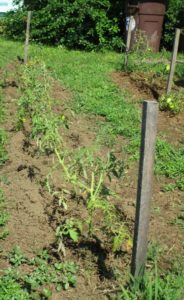
A last planting of tomatoes – various Chef Jeff’s brand – in the garden.
WATERING THE GARDEN: I water the garden daily, giving it a good soaking before 10 a.m. I either use hose-and-sprinkler, tapping house water, or I use a sprinkling can, using mostly rain, recycled cellar dehumidifier water, or recycled water from my sprinkling. When I use the hose-sprinkler system, I aim for 20 minutes; When I use the sprinkling can, I probably would use about 30 gallons to cover my entire garden of approximately 315 row-feet, or about 950 square feet. But, now, I am re-thinking this – Perhaps, I should go to a more soaking sprinkling, but fewer times a week. Thoughts?
AROUND THE YARD: Knock Out roses are starting to bloom for a second time this season.
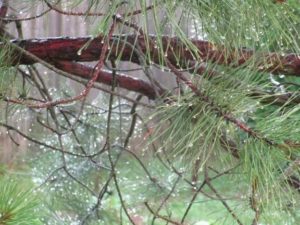
Rain clinging to a pitch pine, “Pinus rigida,” in my backyard.
FEEDING BIRDS IN THE YARD: This summer, I am trying something different – essentially not feeding birds, except with the finch feeder. I am keeping the finch feeder because I love the colorful males of the state bird, the eastern goldfinch, “Spinus tristis.” The idea of not feeding this summer is to let the birds enjoy my yard, with the three birdbaths I keep filled, and help me by eating insects. Birds, nature’s pesticide! Of course, not buying expensive bird seed saves money. However, I still have seed in a garbage pail in the garage. When I am home, I usually have the garage door open and, of course, the squirrels, “Sciurus carolinensis,” have discovered the garbage pail. Clang! That is the sound of the squirrels knocking something down as they open the garbage pail.
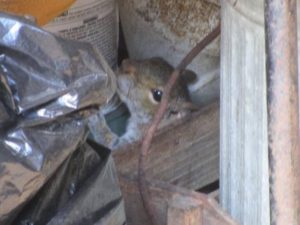
A birdseed thief trying to hide in the garage.
PEDDIE LAKE: Peddie Lake, created by the damming of Rocky Brook, is approximately 15 acres in Hightstown, Mercer County. Rocky Brook is a tributary of the Millstone River, part of the Raritan River-Bay watershed.
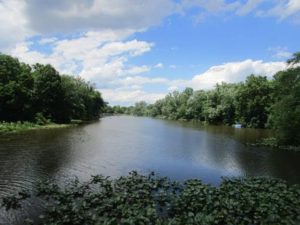
Peddie Lake
NIGHT SKY: After the Saturday, July 1, storms, the night sky was clear around 10 p.m., offering a southwest view of the half moon, the bright planet Jupiter to the lower right, and the star Spica to the lower left. The moon is waxing to the Full Thunder Moon on the July 8-9, Saturday-Sunday, overnight. Jupiter is the largest of our solar system’s eight confirmed planets. It is in orbit on the other side of Mars from Earth. Earth is in the third orbit, Mars in the fourth, and Jupiter in the fifth. Jupiter ranges 365 million miles to 601 million miles from Earth. Spica is the 16th brightest star seen from Earth. It is 260 light-years away — that is, about 186,000 miles per second over 260 years.

The moon with Jupiter to the right and Spica to the left.
SUNRISE/SUNSET: For July 2, Sunday, to July 8, Saturday, the sun will rise at about 5:35 a.m. and set about 8:30 p.m.
WEATHER: The National Weather Service forecasting station for the area is at http://www.weather.gov/phi/.
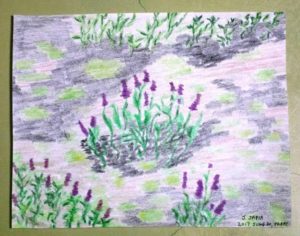
“Pickerel Weed in Bloom at Helmetta Pond,” plein air, colored pencils.
Joe Sapia, 60, is a lifelong Monroe resident. He is a Pine Barrens naturalist and an organic vegetable-fruit gardener.
He gardens the same backyard plot as did his Italian-American father, Joe Sr., and his Polish-immigrant, maternal grandmother, Annie Poznanski Onda. Both are inspirations for his food gardening. Joe is active with the Rutgers University Master Gardeners/Middlesex County program. He draws inspiration on the Pine Barrens around Helmetta from his mother, Sophie Onda Sapia, who lived her whole life in these Pines, and his Grandma Annie.
Joe’s work also is at @JosephSapia on Twitter.com, along with Facebook.com on the Jersey Midlands page.



























































































































































